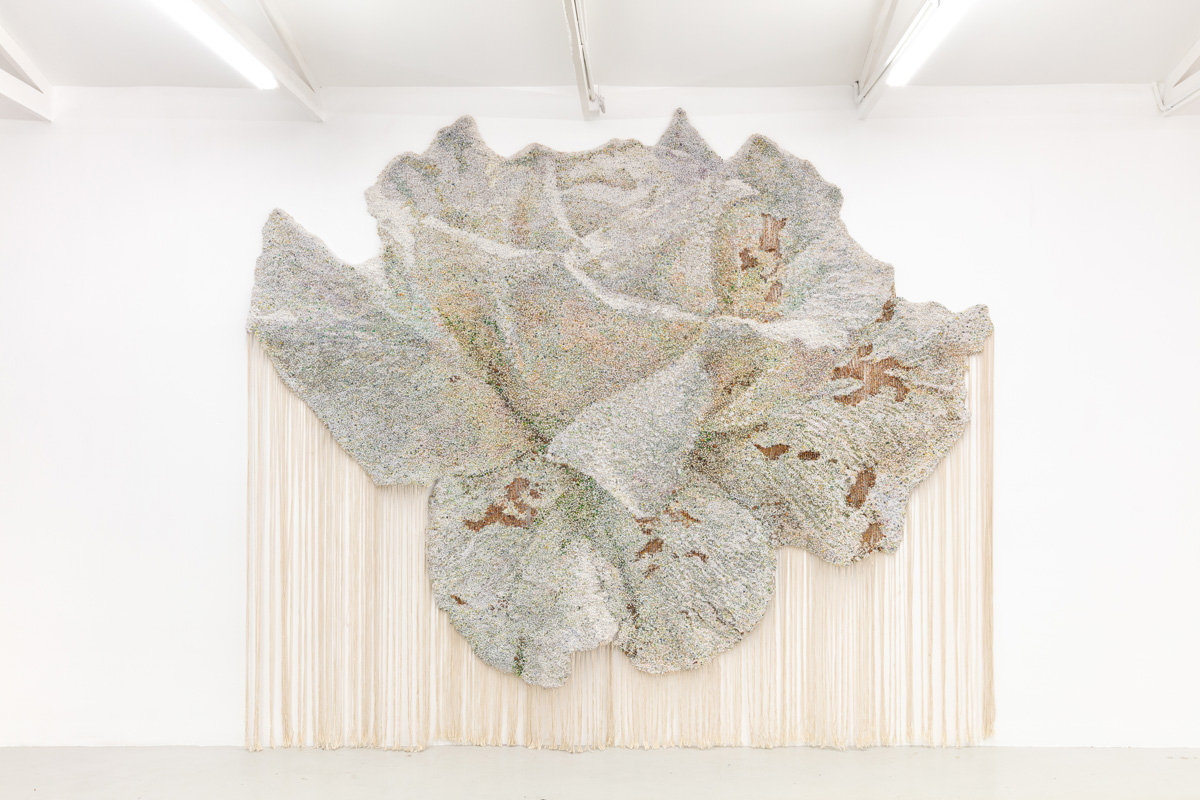
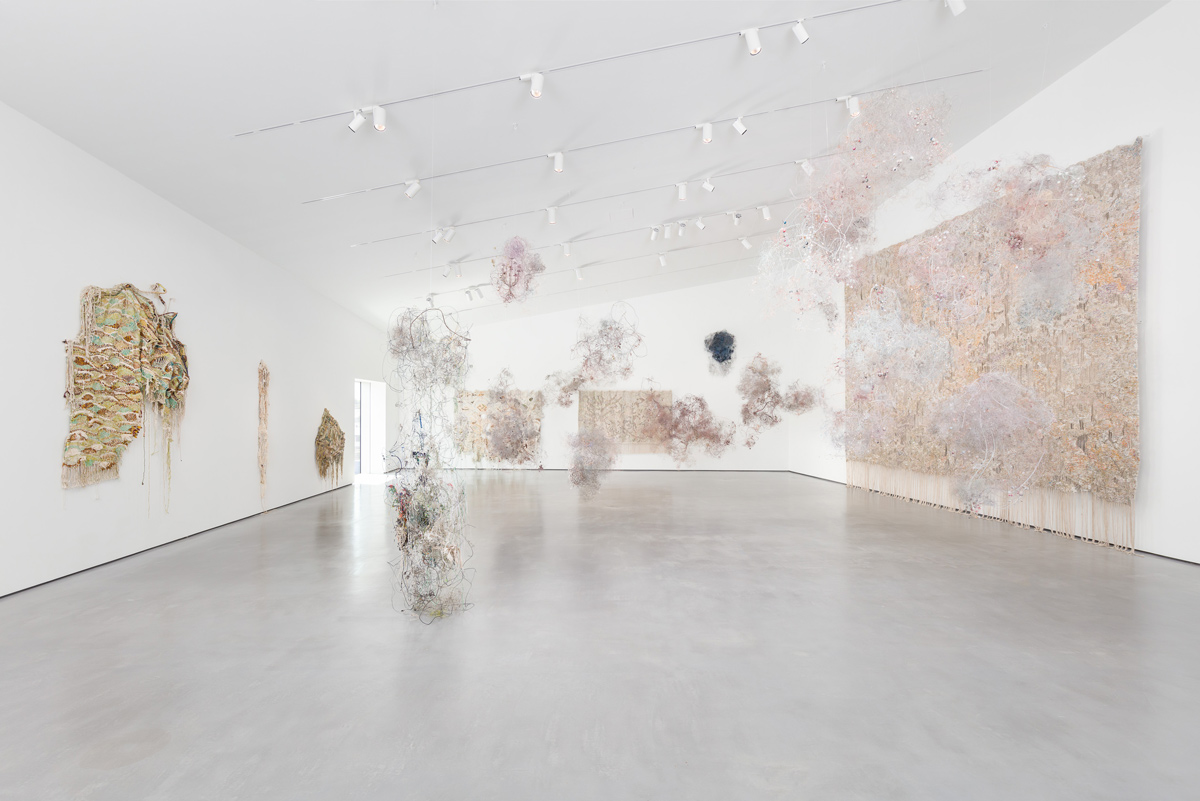
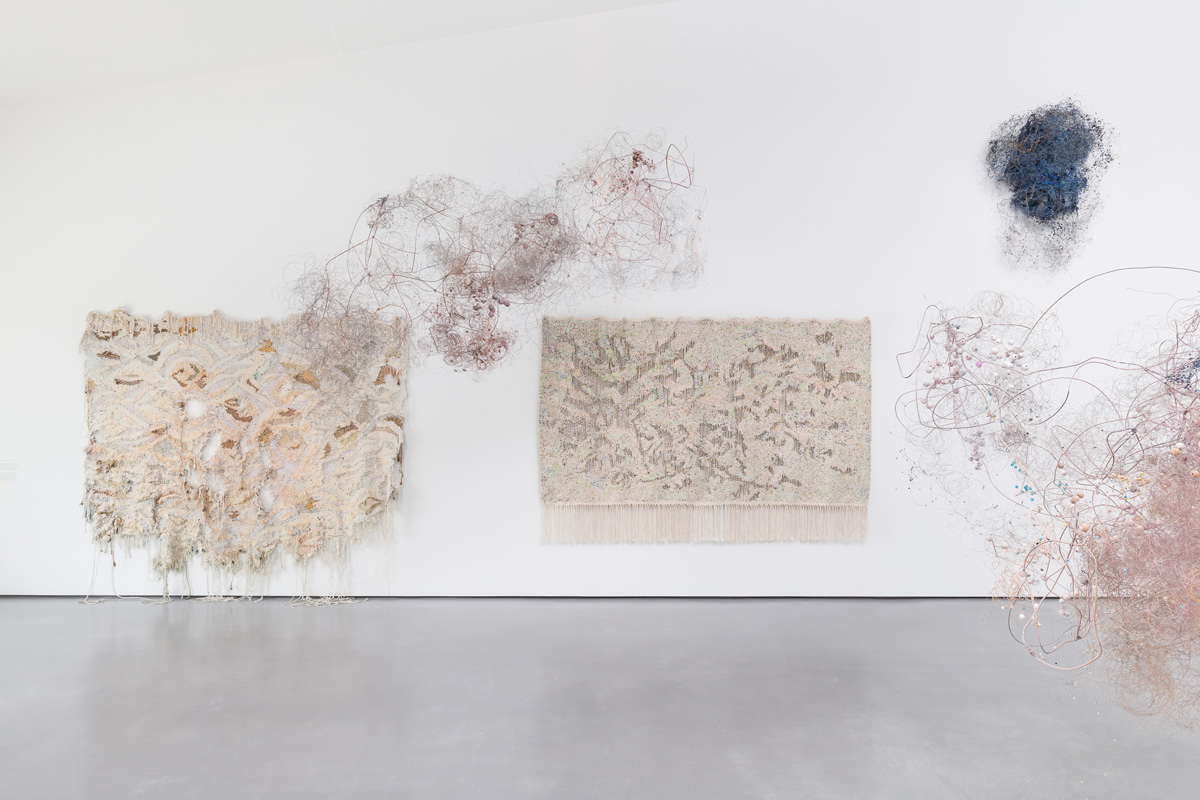
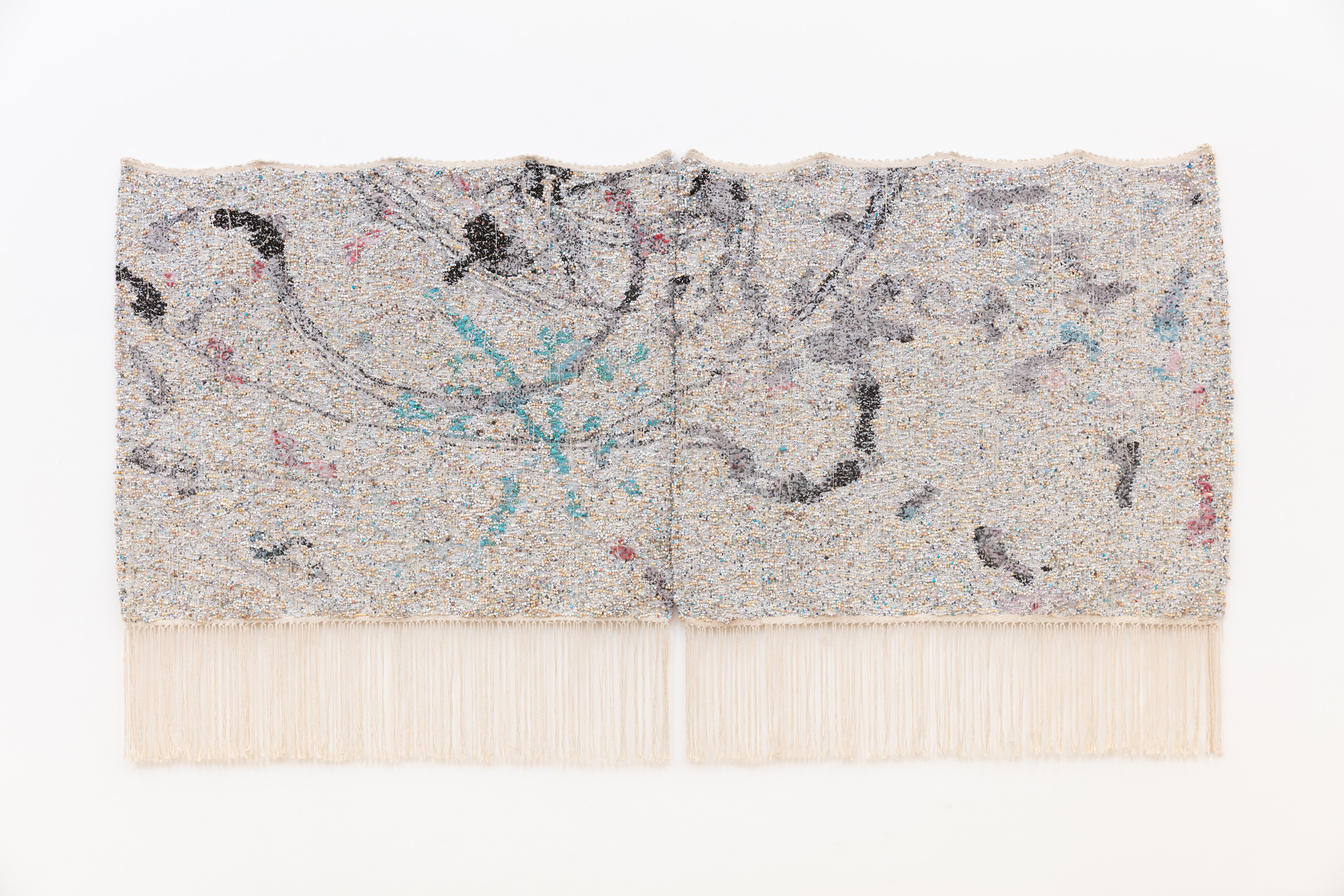
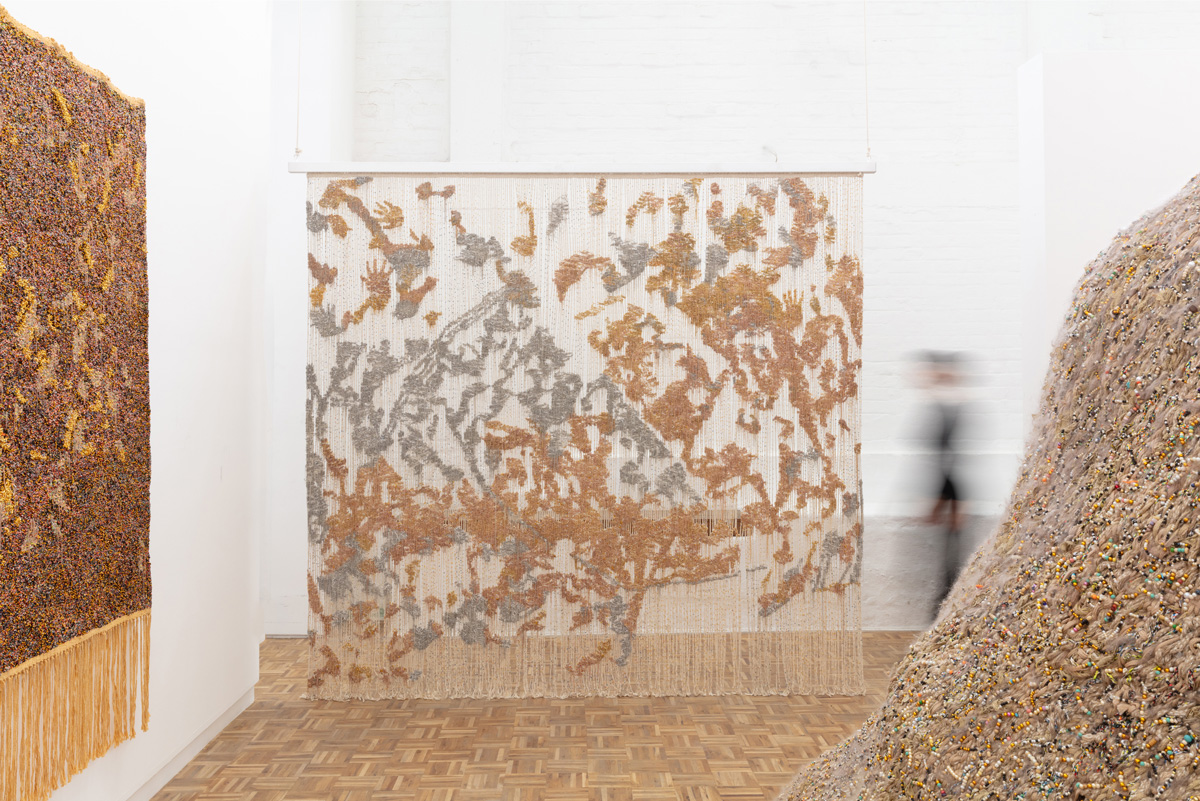


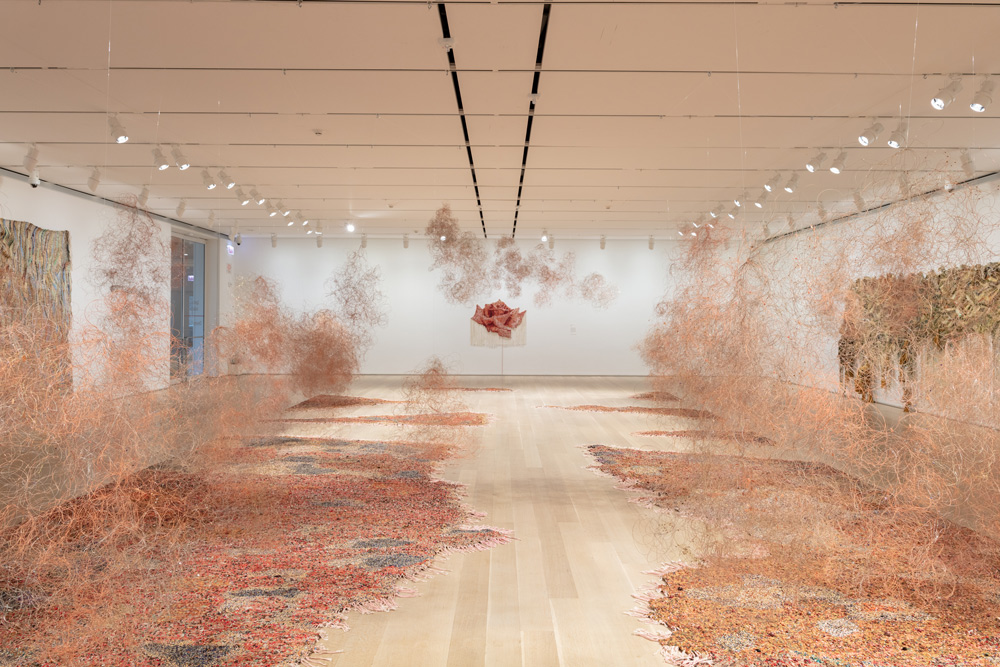





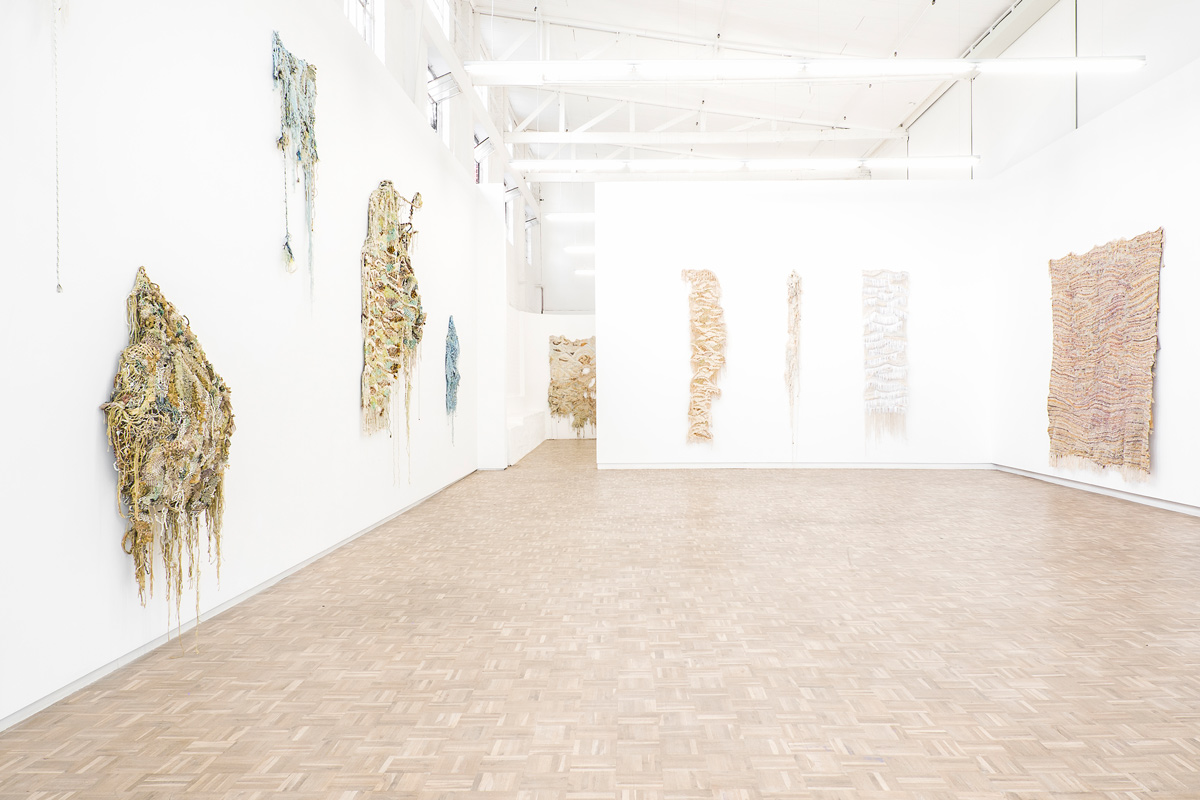


Igshaan Adams’s practice coalesces performance, weaving, sculpture and installation. Born in Bonteheuwel, a suburb in Cape Town, South Africa, Adams draws upon his background to contest racial, sexual and religious boundaries. This intersectional topography remains visible throughout his practice and serves as a palimpsest upon which traces of personal histories are inscribed and reinscribed. He explains; “I’m interested in the personal stories recorded on the surface. What is recorded is not necessarily always a factual account but can be what is imagined - a combination of myth-making and meaning-making”.
Adams approaches materiality through his own subjectivity. Often, cultural and religious references are used in conjunction with surfaces that have always been present throughout his life; thread, beads, wire, linoleum, cotton twine, fabric. His interest in the material oscillates between the intuitive process of handling different substances as well as a formal inquiry into how various materials behave in different contexts and how they transfigure or evolve depending. Likening the material’s potential for evolution to his own potential for evolution, Adams is engaged in broadening his ideas of selfhood in an ongoing process of covering and uncovering, doing and undoing.
To date, Adams has held solo exhibitions at ICA Miami (Miami), Hill Art Foundation (New York), ARoS Aarhus Art Museum (Denmark), The Hepworth Wakefield (England), Institute of Contemporary Art Boston, The Art Institute of Chicago, Kunsthalle Zurich, Hayward Gallery (London), SCAD Museum of Art (Savannah), Akershus Kunstsenter (Oslo), and Iziko South African National Gallery (Cape Town), among others. He has also participated in numerous international group shows, including Stockholm Cosmologies at Liljevalchs in Stockholm (2025); Recipes for Broken Hearts at the Bukhara Biennial in Uzbekistan (2025); Imagining Black Diasporas: 21st Century Art and Poetics at LACMA (2025); Unravel: The Power and Politics of Textiles in Art at Barbican Centre London (2024) and The Stedelijk Museum Amsterdam (2024); Woven Histories: Textiles and Modern Abstractions at LACMA, National Gallery of Art DC, National Gallery of Canada and Museum of Modern Art (2023-2025); Choreographies of the Impossible, the São Paulo Biennale (2023); Awwal Bayt, the Islamic Arts Biennale (2023) in Jeddah, and The Milk of Dreams (2022) at the Venice Biennale.
Adams has been selected for a number of artist residencies including the Atelier residency at Zeitz MOCAA in Cape Town, A4 Arts Foundation in Cape Town, the Sommerakademie im Zentrum Paul Klee in Bern, and the IAAB Pro Helvetia residency in Basel. In 2018, Adams was awarded the Standard Bank Young Artist Award for Visual Art. His works are included in numerous public collections, including the Block Museum (Northwestern University, Chicago, USA) ARoS Aarhus Art Museum (Aarhus, Denmark), Guggenheim Abu Dhabi (Abu Dhabi, United Arab Emirates), Speed Art Museum (Kentucky, USA), Los Angeles County Museum of Art (Los Angeles, USA), CA Solomon R. Guggenheim Museum (New York, USA), Art Gallery of New South Wales (Sydney, Australia), Moderna Museet (Stockholm, Sweden), Art Institute of Chicago (Chicago, USA), Stedelijk Museum (Amsterdam, Netherlands), Tate Modern (London, UK), Baltimore Museum of Art (Baltimore, USA), Inhotim Museum (Brazil), Iziko South African National Gallery (Cape Town, South Africa), Minneapolis Institute of Art (Minneapolis, USA), Standard Bank collection (Johannesburg, South Africa) and University of Cape Town collection (Cape Town, South Africa).
—
curriculum vitae
1982 Born in Cape Town, South Africa
education
2009 Diploma in Fine Art, Ruth Prowse School of Art, Cape Town
2003 National Certificate (N6) in Art & Design, College of Cape Town
solo exhibitions
2026 Between Then and Now, Mudam Luxembourg, Luxembourg [upcoming]
2025 Lulu, Zanele, Zandile, Savannah, ICA Miami, Miami, USA
2025 Igshaan Adams: I’ve been here all along, I’ve been waiting, Hill Art Foundation, New York, USA
2025 Verkenning, Casey Kaplan, New York, USA
2025 Igshaan Adams - Weerhoud, ARoS, Aarhus, Denmark
2024 Holy Terrain, blank projects, Cape Town, South Africa
2024 Igshaan Adams: Weerhoud, Hepworth Wakefield, Wakefield, UK
2024 Lynloop, Institute of Contemporary Art Boston, Boston, USA
2023 Primêre Wentelbaan, Thomas Dane Gallery, London, UK
2022 Vastrapplek, Casey Kaplan Gallery, New York, USA
2022 Desire Lines, The Art Institute of Chicago, Chicago, USA
2022 skarrelbaan, blank projects, Cape Town, South Africa
2021 Kicking Dust, Kunsthalle Zurich, Switzerland
2021 Kicking Dust, Hayward Gallery, London, UK
2021 Veld Wen, Casey Kaplan Gallery, New York, USA
2020 Getuie, SCAD Museum of Art, Savannah, USA
2020 stukkinne stories, blank projects, Cape Town, South Africa
2019 I am no more, Akershus Kunstsenter, Oslo, Norway
2018 When Dust Settles, institutional tour, South Africa
2018 Al Latîf, blank projects, Cape Town, South Africa
2016 Oorskot, blank projects, Cape Town, South Africa
2015 Please Remember, A Tale of a Tub, Rotterdam, Netherlands
2015 Parda, blank projects, Cape Town, South Africa
2013 Have you seen Him?, blank projects, Cape Town, South Africa
2013 If that I knew, Rongwrong Gallery, Amsterdam, Netherlands
2011 In Between, Stevenson Gallery, Cape Town, South Africa
2010 Vinyl, AVA Gallery, Cape Town, South Africa
2009 Jou Ma se Poes, Ruth Prowse School of Art, Cape Town, South Africa
selected group exhibitions
2025 Stockholm Cosmologies, Liljevalchs, Stockholm, Sweden
2025 By the Movement of All Things, Lawrie Shabibi, Dubai, UAE
2025 Recipes for Broken Hearts, Bukhara Biennial, Bukhara, Uzbekistan
2025 Structures, JCAF, Johannesburg, South Africa
2025 Sightlines, A4 Arts Foundation, Cape Town, South Africa
2025 Black Earth Rising, Baltimore Museum of Art, Baltimore, USA
2025 Woven Histories: Textiles and Modern Abstractions, MoMA, New York, USA
2024 Imagining Black Diasporas: 21st-Century Art and Poetics, LACMA, Los Angeles, USA
2024 space of togetherness, Drama School of the National Theatre of Greece | School of Athens – Irene Papas, Athens, Greece
2024 Unravel - The Power and Politics of Textiles in Art, Stedelijk Museum Amsterdam, Amsterdam, The Netherlands
2024 Leaps of Faith, Z33 House for Contemporary Art, Design & Architecture, Hasselt, Belgium
2024 Unravel: The Power and Politics of Textiles in Art, Barbican Art Gallery, London, UK
2023 Woven Histories: Textiles and Modern Abstractions, LACMA, Los Angeles, USA
2023 Choreographies of the Impossible, Bienal de São Paulo, São Paul, Brazil
2023 Stranger in the Village: Reflecting on Racism with James Baldwin, Aargauer Kunsthaus, Aarau, Switzerland
2023 How do we know the world?, Baltimore Museum of Art, Baltimore, USA
2023 Collector's Focus: The Kilbourn Collection, Norval Foundation, Cape Town, South Africa
2023 lO, blank projects, Cape Town, South Africa
2023 Narrative Threads: Textile Art Now, Moody Center for the Arts, Houston, USA
2023 Awwal Bayt (First House), Islamic Arts Biennale, Jeddah, Saudi Arabia
2022 Dreamhome: Art and Shelter, The Art Gallery of New South Wales, Sydney, Australia
2022 Where do I begin?, Stevenson, Cape Town, South Africa
2022 Unknown Unknowns: An Introduction to Mysteries, 23rd Triennale Milano, Milan, Italy
2022 Customs, curated by Josh Ginsburg and Sumayya Vally, A4 Arts Foundation, Cape Town, South Africa
2022 The Milk of Dreams, 59th International Art Exhibition of the Venice Biennale, Venice, Italy
2021 A Line Beyond, AVA Gallery, Cape Town, South Africa
2021 Slowly Arriving, Kunsthaus Baselland, Basel, Switzerland
2021 I have made a place, Norval Foundation, Cape Town, South Africa
2021 Step Out of Your Body, Enter New Ones – An Exhibition On Community and Spirituality curated by Raphael Gygax, Galerie Peter Kilchmann, Zurich, Switzerland
2021 Where the threads are worn, Casey Kaplan Gallery, New York, USA
2020 WHO ARE WE ARE WHO, curated by Fabian Schöneich, Braunsfelder, Cologne, Germany
2020 Allied with Power, Perez Art Museum Miami (PAMM), USA
2020 Tomorrow there will be more of us, Stellenbosch Triennale, Stellenbosch, South Africa
2019 Risk, curated by Josh Ginsburg, A4 Arts Foundation, Cape Town, South Africa
2019 Ngoma: Art and Cosmology, JAG, Johannesburg, South Africa
2019 the head the hand, blank projects, Cape Town, South Africa
2019 Mapping Black Identities, Minneapolis Institute of Art, Minneapolis, USA
2019 Kubatana, Vestfossen Kunstlaboratorium, Øvre Eiker, Norway
2019 Matters of Concern, La Verrière, Brussels, Belgium
2019 Material Insanity, MACAAL, Marrakech, Morrocco
2019 Filling in the Gaps, Iziko South African National Gallery, Cape Town, South Africa
2019 CONDO London, blank projects hosted by Corvi-Mora, London, UK
2018 open agenda, blank projects, Cape Town, South Africa
2018 Soft Power, curated by Julie Crenn, Transpalette, Bourges, France
2018 In This Imperfect Present Moment, Seattle Art Museum, Seattle, USA
2018 Pulling at Threads, Norval Foundation, Cape Town, South Africa
2018 Ravelled Threads, Sean Kelly Gallery, New York, USA
2018 blank, Galerie Guido W. Baudach, Berlin, Germany
2018 Sculpture, Institute of Contemporary Art Indian Ocean, Port Louis, Mauritius
2018 Da Uno a Dieci, Galleria Massimo Minini, Brescia, Italy
2017 Les jour qui vient, Galerie des Galeries, Paris, France
2016 Figure, blank projects, Cape Town, South Africa
2016 The Quiet Violence of Dreams, Stevenson Gallery, Johannesburg, South Africa
2016 3 881 days, blank lab, Cape Town, South Africa
2016 The 55-Minute Hour, Trubok Factory, Cape Town, South Africa
2015 Furniture: a sculpture exhibition, blank projects, Cape Town, South Africa
2015 Sacre du Printemps curated by AA Bronson, Grazer Kunstverein, Graz, Austria
2015 Barriers, Wanås Konst, Knislinge, Sweden
2014 next thing you know, blank projects, Cape Town, South Africa
2014 No Fixed Abode, The New Church Museum, Cape Town, South Africa
2014 Blind Spot, National Arts Festival, Grahamstown, South Africa
2014 Between Subject and Object, Michaelis Galleries, Cape Town, South Africa
2014 Bismillah, National Arts Festival, Grahamstown, South Africa
2013 Three Abdullahs, Centre for African Studies, Cape Town, South Africa
2013 This is the thing, blank projects, Cape Town, South Africa
2013 blank projects in Johannesburg, Ithuba Arts Gallery, Johannesburg, South Africa
2012 When Form Becomes Attitude, blank projects, Cape Town, South Africa
2012 Ingekluer: Beyond The Borders, AVA Gallery, Cape Town, South Africa
2012 A Century of Self, The Copy Shop, Cape Town, South Africa
2011 What We Talk About When We Talk About Love, Stevenson, Cape Town, South Africa
2011 Slices of Life, Infecting the City Public Arts Festival, Cape Town, South Africa
2010 Laboratory of Recycled Revolutions, Greatmore Studios, Cape Town, South Africa
2010 Swallow my Pride, blank projects, Cape Town, South Africa
2010 Greatest Hits 2009, AVA Gallery, Cape Town, South Africa
selected awards + residencies
2023 Not Working (Working Title), Atelier residency, Zeitz MOCAA, Cape Town, South Africa
2020 Open Production, A4 Arts Foundation, Cape Town, South Africa
2019 I.D.E.A. Residency Project, Nicoletta Rusconi Art Projects, Milan, Italy
2018 Standard Bank Young Artist of the Year Award for Visual Art, South Africa
2015 A Tale of a Tub, Rotterdam, Netherlands
2014 Sommerakademie im Zentrum Paul Klee in Bern, Switzerland
2013 IAAB / Pro Helvetia residency, Basel, Switzerland
collections
Block Museum, Northwestern University, Chicago
ARoS Aarhus Art Museum
Guggenheim Abu Dhabi, Abu Dhabi
Speed Art Museum, Kentucky
Tate, London
LACMA, Los Angeles
The Stedelijk Museum Amsterdam, Amsterdam
Solomon R. Guggenheim Museum, New York
Art Gallery of New South Wales, Sydney
Moderna Museet, Stockholm
Art Institute of Chicago, Chicago
Baltimore Museum of Art, Baltimore
Inhotim Museum, Brazil
Iziko South African National Gallery, Cape Town
Minneapolis Institute of Art, Minneapolis
Standard Bank collection, Johannesburg
University of Cape Town collection, Cape Town
— publications
2024 Carrier, MC. (ed) Igshaan Adams: Weerhoud. The Hepworth Wakefield, Wakefield, UK.
2024 Johnson, L., Pinath, A. & Fray-Smith, W. (eds) Unravel: The Power and Politics of Textiles in Art. Prestel Publishing, Munich, Germany.
2023 Cooke, L. (ed) Woven Histories: Textiles and Modern Abstraction. University of Chicago Press, USA.
2022 Bonsu, O. African Art Now: 50 Pioneers Defining African Art for the Twenty-First Century. Chronicle Books LLC / Tate, UK.
2022 Folkerts, H et al. Igshaan Adams: Desire Lines. Art Institute of Chicago, Yale University Press, USA.
2021 Underwood, J. L. & Okeke-Agulu, C et al. African Artists: From 1882 to Now. Phaidon Press, UK. Published 17 November 2021.
2019 Martin, C.J. Four Generations: The Joyner / Giuffrida Collection of Abstract Art, Gregory Miller & Co, New York, USA.
2019 O’Toole, S. Igshaan Adams in Vitamin T: Threads and Textiles in Contemporary Art, Phaidon Press, UK.
2018 Igshaan Adams: When Dust Settles, blank projects, South Africa.
2019 Boulle, C & Pather, J. Acts of Transgression: Contemporary Live Art in South Africa. Wits University Press.
2017 Igshaan Adams, blank projects, South Africa.
— selected press
2025 Gibbson, A.J. The Outsize Artistic Legacy of Koyo Kouoh|Vogue [online] (published 14 May 2025)
2025 Harrison, J. The Best Booths at Art Basel Hong Kong 2025 - From a Gold-Digging Video Game Extravagant Installations|Artnews [online] (published 27 March 2025)
2025 Krynauw, M. Sacred Threads: Igshaan Adams’ ‘Holy Terrain’ at blank projects. ArtThrob [online] (published 07 February 2025)
2024 Schreiber, K. Rich Tapestries and Loose Ends: ‘Woven Histories’ Is Unwieldy in Its Comprehensivenes.Observer [online] (published 01 August 2024)
2024 Castelyn, S. Weerhoud at The Hepworth Wakefield: the spirit of dance animates Igshaan Adams’s reflection on South Africa’s history. The Conversation [online] (published 22 July 2024)
2024 Cumming, L. Ronald Moody: Sculpting Life; Igshaan Adams: Weerhoud; Bharti Kher: Alchemies – review. The Guardian [online] (published 14 July 2024)
2024 Casparie, S. Igshaan Adams: Weerhoud. studio international [online] (published 01 July 2024)
2024 Freeman, L. Igshaan Adams review — fairytale creations must be seen to be believed. The Times [online] (published 23 June 2024).
2024 Smee, S. Why textiles are all the rage in the art world right now. The Washington Post [online] (published 03 May 2024).
2024 Tolsi, N. The Weight of Life. CRAFTS (Issue 298).
2024 Searle, A. Unravel review – a gorgeously excessive tangled knot of a show, full of blood, pain and pleasure. The Guardian [online] (published 14 February 2024)
2024 Woodcock, V. Textile trailblazers receive long-overdue recognition. Financial Times [online] (published 28 January 2024).
2023 Peterson, V. Igshaan Adam’s Lines of Desire. Frieze [online] (published 27 September 2023).
2023 Lima, AL. Igshaan Adams: A Body of Work. African Arts. 56(3) 72-81.
2023 Rotwein, H. Looking for South Africa, But Seeing Nando’s. D Magazine [online] (published 3 July 2023).
2023 Vally, S. The world’s first Islamic art biennale shines a light on Muslim African artists. The Conversation [online] (published 9 March 2023).
2023 Khalil, N. 10 Standout Artists at the Inaugural Islamic Arts Biennale. Artsy [online] (published 2 February 2023).
2023 Al Bustani, H. Islamic Arts Biennale opens, exploring the magnetism of faith at the gateway to Makkah. The National News [online] (published 23 January 2023).
2022 Bourland, I. Igshaan Adams Interweaves the Mundane with the Divine. Frieze [online] (published 22 November 2022).
2022 Hopkins, Z. Critic’s Picks: Igshaan Adams. Artforum. Published December 2022.
2022 Cooke, L. Top Ten: Lynne Cooke’s highlights of 2022. Artforum. December 2022 issue.
2022 O’Toole, S. Material World. Private Edition (Issue 55).
2022 About the Rose: Igshaan Adams and Hendrik Folkerts in Conversation. Art Institute of Chicago. [online] (published 19 July 2022).
2022 Dango, M. Worklines: Michael Dango on the art of Igshaan Adams. Artforum (Summer 2022, Vol. 60, No. 10).
2022 O Toole, S. South African artists taking over Chicago, Bonteheuwel style. Mail and Guardian (published 6 May 2022).
2022 Here Are 9 Exciting Artists Whose Markets Are Poised to Reach the Next Level After Remarkable Outings at the Venice Biennale. Artnet News. [online] (published 5 May 2022).
2022 Mitter, S. Art That Finds Clarity in South Africa's Fraught Terrain. The New York Times. (published 28 April 2022).
2022 Higgins, H. The Art Institute Unveils New Exhibits. Loyola Phoenix. [online] (published 20 April 2022).
2022 Hlalethwa, Z. Igshaan Adams asks, 'Would you treat me differently if you knew everything about me?' News24. [online] (published 15 April 2022).
2022 Solomon, T. For His First U.S. Museum Show, Igshaan Adams Creates Tapestries That Reflect on South African History. ARTnews. [online] (published 5 April 2022).
2022 Malik, T. Igshaan Adams on Mapping Desire Lines: in conversation with Tarini Malik. Ocula Magazine. [online] (published 23 March 2022).
2022 Barrell, O. Skarrelbaan: A recent exhibition by Igshaan Adams. Art Formes. [online] (published 19 March 2022).
2022 Installation view: Igshaan Adams: Kicking Dust. Contemporary And. [online] (published 11 March 2022).
2022 Thurman, C. On the make with Igshaan Adams' 'skarrelbaan'. Business Day Wanted Magazine. (published 4 March 2022).
2022 Moloi, N. The “biennialization” of the art world | South Africans in Venice. Bubblegumclub. [online] (published March 2022).
2022 Moloi, N. ‘skarrelbaan’ | grit and beauty in the works of Igshaan Adams. Bubblegumclub. [online] (published 14 February 2022).
2022 Myers, L. Igshaan Adams brings cloud-like sculptures and woven pathways to Kunsthalle Zurich. Designboom. [online] (published 11 February 2022).
2022 Zheng, E. Cape Town Art Week 2022: Exhibitions to See. Ocula Magazine. [online] (published 9 February 2022).
2021 Kuijers, I. Desire Lines: Igshaan Adams’ ‘Kicking Dust’ at Hayward Gallery’. ArtThrob. [online] (published 29 July 2021).
2021 Balfour, R. J. & Postma, L. The Dis/entanglements of Knowledge: Transversing Matter, Subjectivity and Identity in VS Naipaul and Igshaan Adams. Neohelicon.
2021 Ghosh, R. Igshaan Adams Rewrites the Countours of Domestic Life in HIs Linoleum-Inspired Art. Elephant Art. [online] (published 22 July 2021).
2021 Noor, T. 3 Art Gallery Shows to See Right Now. The New York Times. [online] (published 14 July 2021).
2021 Cassell, D.L. & Packard, C. Your Concise New York Art Guide for July 2021. Hyperallergic. [online] (published 13 July 2021).
2021 Provenzi, R. Igshaan Adams. Sculpture Magazine. [online] (published 6 July 2021).
2021 Burlington, G. In Intricate Weavings, Igshaan Adams Maps South Africa’s Tangled Histories. Hyperallergic. [online] (published 27 June 2021).
2021 Behringer, D. Surprising Materials and Literal Pathways: The Tapestries of Igshaan Adams. Design Milk. [online] (published 29 June 2021).
2021 Mason, F. Matthew Barney. London Review of Books. [online] (published 17 June 2021).
2021 Corrigall, M. The term ‘emerging’ might not be serving artists. Maverick Life. [online] (published 9 June 2021).
2021 The Monocle Minute: Points of View. Monocle [online] (published 4 June 2021).
2021 Adebayo, B. Igshaan Adams. Nataal. [online] (published 20 May 2021).
2021 Cumming, L. Matthew Barney: Redoubt; Igshaan Adams: Kicking Dust – review. The Guardian [online] (published 16 May 2021).
2020 Kabov, V. Syncretic Hands: African philosophy, abstraction and materiality in the work of Igshaan Adams, Ibrahim Mahama and Moffat Takadiwa. [online].
2021 Gurney, K. Kicking Dust: Communal pathways as works of art. [in review] [online] (published 23 January 2021).
2020 Chemaly, T. Igshaan Adams: Personal Devotion. TL Magazine [online] (published 22 May 2020).
2020 Shinners, K. Casting Spells: The Stellenbosch Triennale. ArtThrob [online] (published 24 February 2020).
2020 Nelson, E J. The Importance of Ritual: A Conversation with Igshaan Adams. Burnaway [online] (published 21 February 2020).
2020 Moloi, N. Against erasure and forgetting: Sabelo Mlangeni and Igshaan Adams at blank projects, Artthrob [online] (published 11 February 2020).
2020 Maota, R. Artist Profile: Meet Igshaan Adams, A Mixed Media Artist. Zkhiphani [online] (published 28 January 2020).
2019 Sebambo, K. Igshaan Adams: a Journey Inward, Art Momentum, South Africa (published 7 March 2019).
2019 Allie, N. When the dust settles a conflict of identities remains, Business Day, South Africa (published 23 January 2019).
2019 Hemmings, J. Igshaan Adams: Material Traces, Norwegian Crafts, Norway (published 23 January 2019).
2018 Tsotsi, T. Igshaan Adams: When Dust Settles “Collective Limitations”, Contemporary And [online] (published 31 October 2018).
2018 Wood, G. Artist Igshaan Adams stitches together the sacred and ordinary, Wanted Magazine, South Africa (published 20 August 2018).
2018 Standard Bank Young Artist Award winner Igshaan Adams challenges stilted ways of thinking with provocative work, Sunday Times, South Africa (published 5 August 2018).
2018 Drysdale, C. Uncanny Nostalgia: Igshaan Adams ‘When Dust Settles’, ArtThrob [online] (published 10 July 2018)
2018 Maroga, K. A Subtle Benediction: Igshaan Adams ‘Al Latîf’, ArtThrob [online] (published 23 February 2018).
2018 Igshaan Adams’ ‘Al Latîf’ at blank projects, Cape Town, BLOUIN ARTINFO [online] (published 17 February 2018).
2019 Dodd, A. Metamorphic Material: Anatsui, Adams, Marx. De Arte. 54(3): 41–58.
2017 Igshaan Adams puts soul into his art, Cape Argus, South Africa (published 3 November 2017).
2016 Interview with Igshaan Adams, adjective [online] (published 16 September 2016).
2016 Pinto, G. Igshaan Adams is disarming us with quiet activism, Between10and5 [online] (published September 2016).
2016 Barnitz, M and Goyke, L. Representations of queerness in documentary films and art, Freie Universität Berlin student wiki [online] (published 29 January 2016).
2015 Islamic Tradition meets Post-Apartheid Identity in Igshaan Adams Intricat Tapestries, Artsy Magazine [online] (published 15 June 2015).
2015 Pollak, L. Faith and Ambiguity: Igshaan Adams’ Parda, ArtThrob [online] (published 9 March 2015).
2015 O’Toole, S. Critics picks: Igshaan Adams, Artforum International (published January 2015).
2015 Ball, J. Inkblots and their indices: rethreading perceptions in the work of Igshaan Adams, Image & Text, South Africa (issue 25) (published 2015).
2014 Kinsman, H. Tracing Emerging Artistic Practice in South Africa, Another Africa [online] (published 22 September 2014).
2012 Matthews, A. Young African Artists – Igshaan Adams, Business Day, Wanted Magazine, South Africa (published September 2012).
2024 Carrier, MC. (ed) Igshaan Adams: Weerhoud. The Hepworth Wakefield, Wakefield, UK.
2024 Johnson, L., Pinath, A. & Fray-Smith, W. (eds) Unravel: The Power and Politics of Textiles in Art. Prestel Publishing, Munich, Germany.
2023 Cooke, L. (ed) Woven Histories: Textiles and Modern Abstraction. University of Chicago Press, USA.
2022 Bonsu, O. African Art Now: 50 Pioneers Defining African Art for the Twenty-First Century. Chronicle Books LLC / Tate, UK.
2022 Folkerts, H et al. Igshaan Adams: Desire Lines. Art Institute of Chicago, Yale University Press, USA.
2021 Underwood, J. L. & Okeke-Agulu, C et al. African Artists: From 1882 to Now. Phaidon Press, UK. Published 17 November 2021.
2019 Martin, C.J. Four Generations: The Joyner / Giuffrida Collection of Abstract Art, Gregory Miller & Co, New York, USA.
2019 O’Toole, S. Igshaan Adams in Vitamin T: Threads and Textiles in Contemporary Art, Phaidon Press, UK.
2018 Igshaan Adams: When Dust Settles, blank projects, South Africa.
2019 Boulle, C & Pather, J. Acts of Transgression: Contemporary Live Art in South Africa. Wits University Press.
2017 Igshaan Adams, blank projects, South Africa.
— selected press
2025 Gibbson, A.J. The Outsize Artistic Legacy of Koyo Kouoh|Vogue [online] (published 14 May 2025)
2025 Harrison, J. The Best Booths at Art Basel Hong Kong 2025 - From a Gold-Digging Video Game Extravagant Installations|Artnews [online] (published 27 March 2025)
2025 Krynauw, M. Sacred Threads: Igshaan Adams’ ‘Holy Terrain’ at blank projects. ArtThrob [online] (published 07 February 2025)
2024 Schreiber, K. Rich Tapestries and Loose Ends: ‘Woven Histories’ Is Unwieldy in Its Comprehensivenes.Observer [online] (published 01 August 2024)
2024 Castelyn, S. Weerhoud at The Hepworth Wakefield: the spirit of dance animates Igshaan Adams’s reflection on South Africa’s history. The Conversation [online] (published 22 July 2024)
2024 Cumming, L. Ronald Moody: Sculpting Life; Igshaan Adams: Weerhoud; Bharti Kher: Alchemies – review. The Guardian [online] (published 14 July 2024)
2024 Casparie, S. Igshaan Adams: Weerhoud. studio international [online] (published 01 July 2024)
2024 Freeman, L. Igshaan Adams review — fairytale creations must be seen to be believed. The Times [online] (published 23 June 2024).
2024 Smee, S. Why textiles are all the rage in the art world right now. The Washington Post [online] (published 03 May 2024).
2024 Tolsi, N. The Weight of Life. CRAFTS (Issue 298).
2024 Searle, A. Unravel review – a gorgeously excessive tangled knot of a show, full of blood, pain and pleasure. The Guardian [online] (published 14 February 2024)
2024 Woodcock, V. Textile trailblazers receive long-overdue recognition. Financial Times [online] (published 28 January 2024).
2023 Peterson, V. Igshaan Adam’s Lines of Desire. Frieze [online] (published 27 September 2023).
2023 Lima, AL. Igshaan Adams: A Body of Work. African Arts. 56(3) 72-81.
2023 Rotwein, H. Looking for South Africa, But Seeing Nando’s. D Magazine [online] (published 3 July 2023).
2023 Vally, S. The world’s first Islamic art biennale shines a light on Muslim African artists. The Conversation [online] (published 9 March 2023).
2023 Khalil, N. 10 Standout Artists at the Inaugural Islamic Arts Biennale. Artsy [online] (published 2 February 2023).
2023 Al Bustani, H. Islamic Arts Biennale opens, exploring the magnetism of faith at the gateway to Makkah. The National News [online] (published 23 January 2023).
2022 Bourland, I. Igshaan Adams Interweaves the Mundane with the Divine. Frieze [online] (published 22 November 2022).
2022 Hopkins, Z. Critic’s Picks: Igshaan Adams. Artforum. Published December 2022.
2022 Cooke, L. Top Ten: Lynne Cooke’s highlights of 2022. Artforum. December 2022 issue.
2022 O’Toole, S. Material World. Private Edition (Issue 55).
2022 About the Rose: Igshaan Adams and Hendrik Folkerts in Conversation. Art Institute of Chicago. [online] (published 19 July 2022).
2022 Dango, M. Worklines: Michael Dango on the art of Igshaan Adams. Artforum (Summer 2022, Vol. 60, No. 10).
2022 O Toole, S. South African artists taking over Chicago, Bonteheuwel style. Mail and Guardian (published 6 May 2022).
2022 Here Are 9 Exciting Artists Whose Markets Are Poised to Reach the Next Level After Remarkable Outings at the Venice Biennale. Artnet News. [online] (published 5 May 2022).
2022 Mitter, S. Art That Finds Clarity in South Africa's Fraught Terrain. The New York Times. (published 28 April 2022).
2022 Higgins, H. The Art Institute Unveils New Exhibits. Loyola Phoenix. [online] (published 20 April 2022).
2022 Hlalethwa, Z. Igshaan Adams asks, 'Would you treat me differently if you knew everything about me?' News24. [online] (published 15 April 2022).
2022 Solomon, T. For His First U.S. Museum Show, Igshaan Adams Creates Tapestries That Reflect on South African History. ARTnews. [online] (published 5 April 2022).
2022 Malik, T. Igshaan Adams on Mapping Desire Lines: in conversation with Tarini Malik. Ocula Magazine. [online] (published 23 March 2022).
2022 Barrell, O. Skarrelbaan: A recent exhibition by Igshaan Adams. Art Formes. [online] (published 19 March 2022).
2022 Installation view: Igshaan Adams: Kicking Dust. Contemporary And. [online] (published 11 March 2022).
2022 Thurman, C. On the make with Igshaan Adams' 'skarrelbaan'. Business Day Wanted Magazine. (published 4 March 2022).
2022 Moloi, N. The “biennialization” of the art world | South Africans in Venice. Bubblegumclub. [online] (published March 2022).
2022 Moloi, N. ‘skarrelbaan’ | grit and beauty in the works of Igshaan Adams. Bubblegumclub. [online] (published 14 February 2022).
2022 Myers, L. Igshaan Adams brings cloud-like sculptures and woven pathways to Kunsthalle Zurich. Designboom. [online] (published 11 February 2022).
2022 Zheng, E. Cape Town Art Week 2022: Exhibitions to See. Ocula Magazine. [online] (published 9 February 2022).
2021 Kuijers, I. Desire Lines: Igshaan Adams’ ‘Kicking Dust’ at Hayward Gallery’. ArtThrob. [online] (published 29 July 2021).
2021 Balfour, R. J. & Postma, L. The Dis/entanglements of Knowledge: Transversing Matter, Subjectivity and Identity in VS Naipaul and Igshaan Adams. Neohelicon.
2021 Ghosh, R. Igshaan Adams Rewrites the Countours of Domestic Life in HIs Linoleum-Inspired Art. Elephant Art. [online] (published 22 July 2021).
2021 Noor, T. 3 Art Gallery Shows to See Right Now. The New York Times. [online] (published 14 July 2021).
2021 Cassell, D.L. & Packard, C. Your Concise New York Art Guide for July 2021. Hyperallergic. [online] (published 13 July 2021).
2021 Provenzi, R. Igshaan Adams. Sculpture Magazine. [online] (published 6 July 2021).
2021 Burlington, G. In Intricate Weavings, Igshaan Adams Maps South Africa’s Tangled Histories. Hyperallergic. [online] (published 27 June 2021).
2021 Behringer, D. Surprising Materials and Literal Pathways: The Tapestries of Igshaan Adams. Design Milk. [online] (published 29 June 2021).
2021 Mason, F. Matthew Barney. London Review of Books. [online] (published 17 June 2021).
2021 Corrigall, M. The term ‘emerging’ might not be serving artists. Maverick Life. [online] (published 9 June 2021).
2021 The Monocle Minute: Points of View. Monocle [online] (published 4 June 2021).
2021 Adebayo, B. Igshaan Adams. Nataal. [online] (published 20 May 2021).
2021 Cumming, L. Matthew Barney: Redoubt; Igshaan Adams: Kicking Dust – review. The Guardian [online] (published 16 May 2021).
2020 Kabov, V. Syncretic Hands: African philosophy, abstraction and materiality in the work of Igshaan Adams, Ibrahim Mahama and Moffat Takadiwa. [online].
2021 Gurney, K. Kicking Dust: Communal pathways as works of art. [in review] [online] (published 23 January 2021).
2020 Chemaly, T. Igshaan Adams: Personal Devotion. TL Magazine [online] (published 22 May 2020).
2020 Shinners, K. Casting Spells: The Stellenbosch Triennale. ArtThrob [online] (published 24 February 2020).
2020 Nelson, E J. The Importance of Ritual: A Conversation with Igshaan Adams. Burnaway [online] (published 21 February 2020).
2020 Moloi, N. Against erasure and forgetting: Sabelo Mlangeni and Igshaan Adams at blank projects, Artthrob [online] (published 11 February 2020).
2020 Maota, R. Artist Profile: Meet Igshaan Adams, A Mixed Media Artist. Zkhiphani [online] (published 28 January 2020).
2019 Sebambo, K. Igshaan Adams: a Journey Inward, Art Momentum, South Africa (published 7 March 2019).
2019 Allie, N. When the dust settles a conflict of identities remains, Business Day, South Africa (published 23 January 2019).
2019 Hemmings, J. Igshaan Adams: Material Traces, Norwegian Crafts, Norway (published 23 January 2019).
2018 Tsotsi, T. Igshaan Adams: When Dust Settles “Collective Limitations”, Contemporary And [online] (published 31 October 2018).
2018 Wood, G. Artist Igshaan Adams stitches together the sacred and ordinary, Wanted Magazine, South Africa (published 20 August 2018).
2018 Standard Bank Young Artist Award winner Igshaan Adams challenges stilted ways of thinking with provocative work, Sunday Times, South Africa (published 5 August 2018).
2018 Drysdale, C. Uncanny Nostalgia: Igshaan Adams ‘When Dust Settles’, ArtThrob [online] (published 10 July 2018)
2018 Maroga, K. A Subtle Benediction: Igshaan Adams ‘Al Latîf’, ArtThrob [online] (published 23 February 2018).
2018 Igshaan Adams’ ‘Al Latîf’ at blank projects, Cape Town, BLOUIN ARTINFO [online] (published 17 February 2018).
2019 Dodd, A. Metamorphic Material: Anatsui, Adams, Marx. De Arte. 54(3): 41–58.
2017 Igshaan Adams puts soul into his art, Cape Argus, South Africa (published 3 November 2017).
2016 Interview with Igshaan Adams, adjective [online] (published 16 September 2016).
2016 Pinto, G. Igshaan Adams is disarming us with quiet activism, Between10and5 [online] (published September 2016).
2016 Barnitz, M and Goyke, L. Representations of queerness in documentary films and art, Freie Universität Berlin student wiki [online] (published 29 January 2016).
2015 Islamic Tradition meets Post-Apartheid Identity in Igshaan Adams Intricat Tapestries, Artsy Magazine [online] (published 15 June 2015).
2015 Pollak, L. Faith and Ambiguity: Igshaan Adams’ Parda, ArtThrob [online] (published 9 March 2015).
2015 O’Toole, S. Critics picks: Igshaan Adams, Artforum International (published January 2015).
2015 Ball, J. Inkblots and their indices: rethreading perceptions in the work of Igshaan Adams, Image & Text, South Africa (issue 25) (published 2015).
2014 Kinsman, H. Tracing Emerging Artistic Practice in South Africa, Another Africa [online] (published 22 September 2014).
2012 Matthews, A. Young African Artists – Igshaan Adams, Business Day, Wanted Magazine, South Africa (published September 2012).

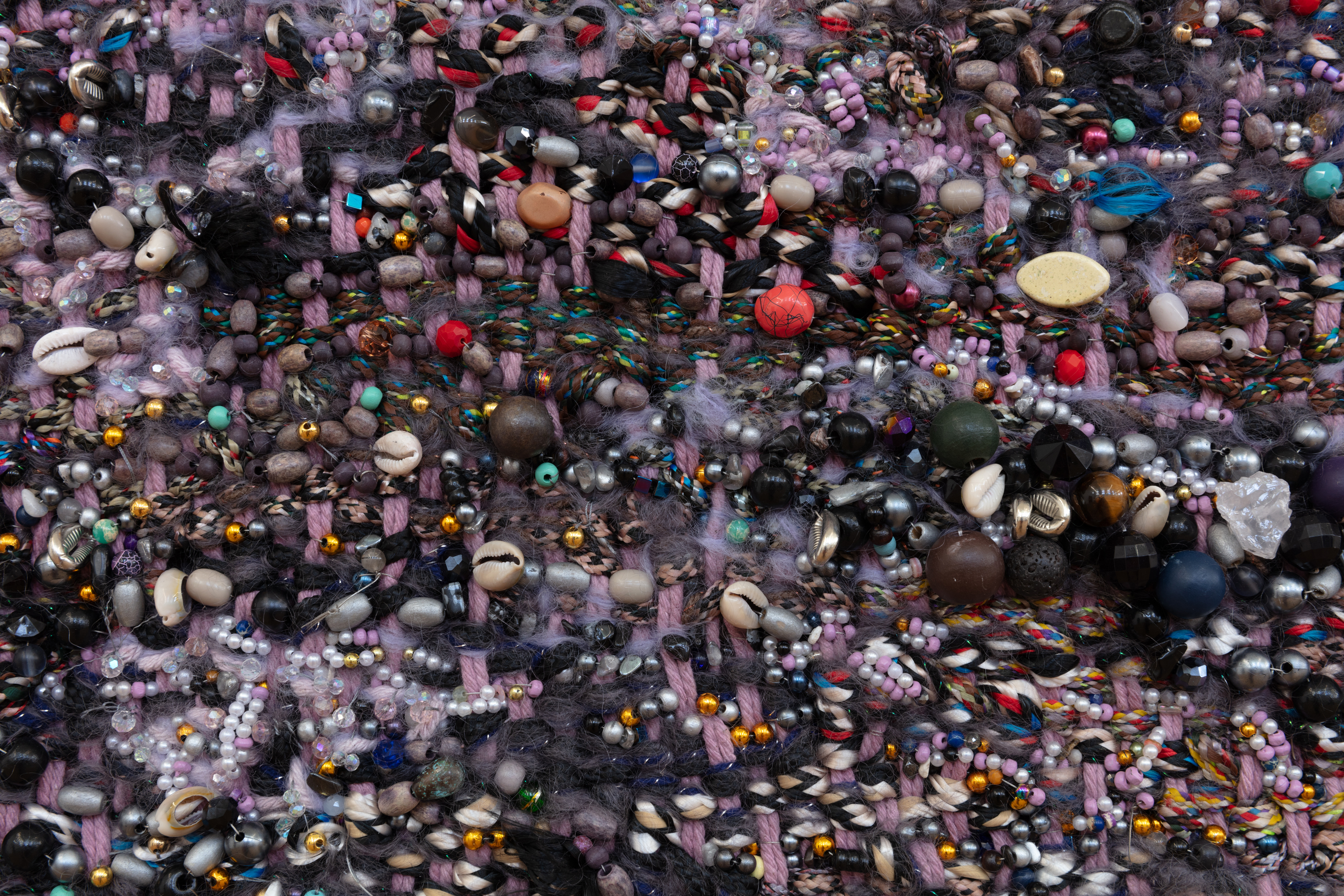
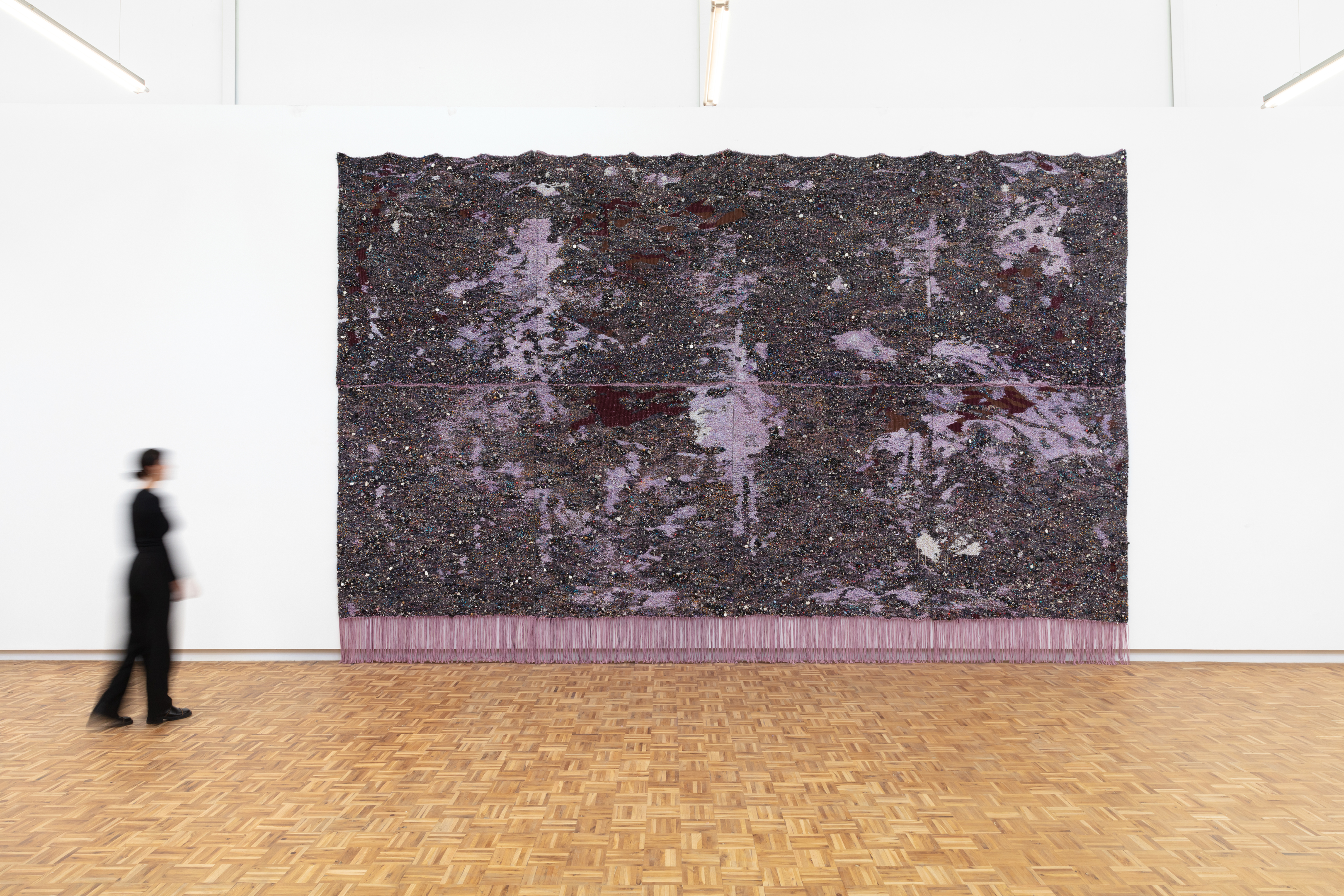
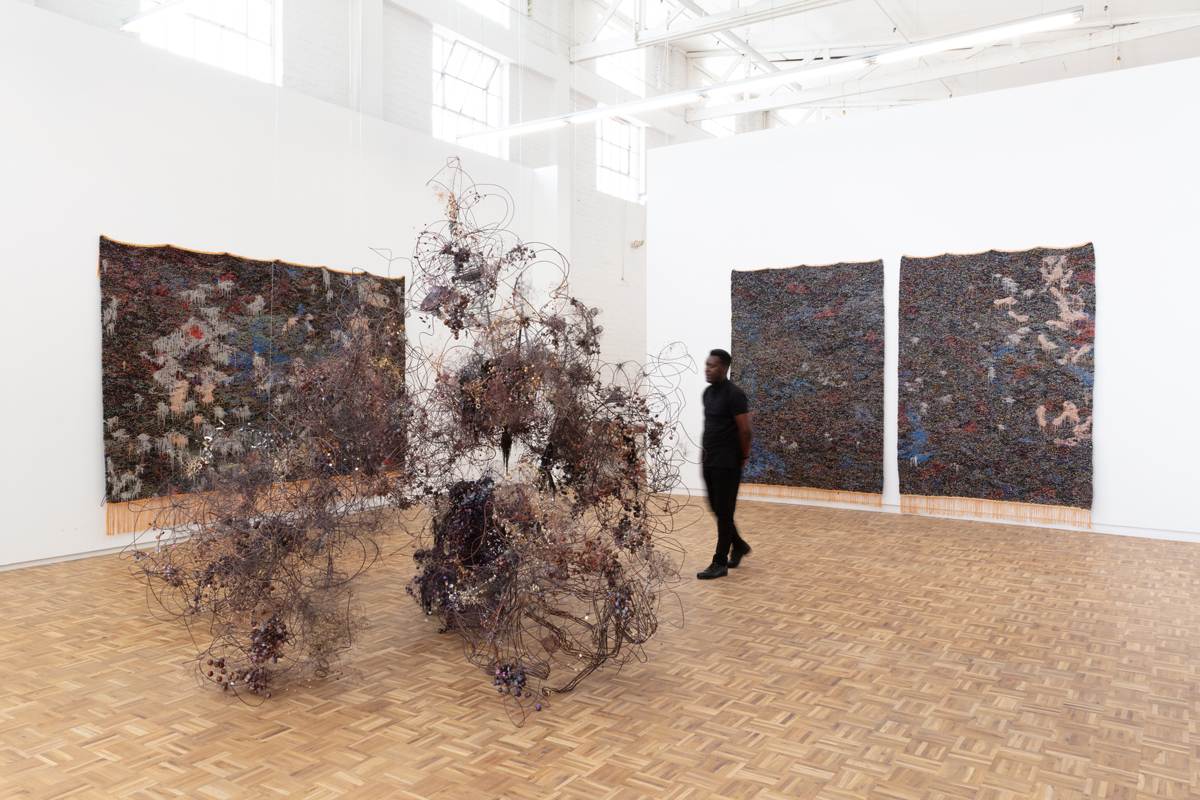


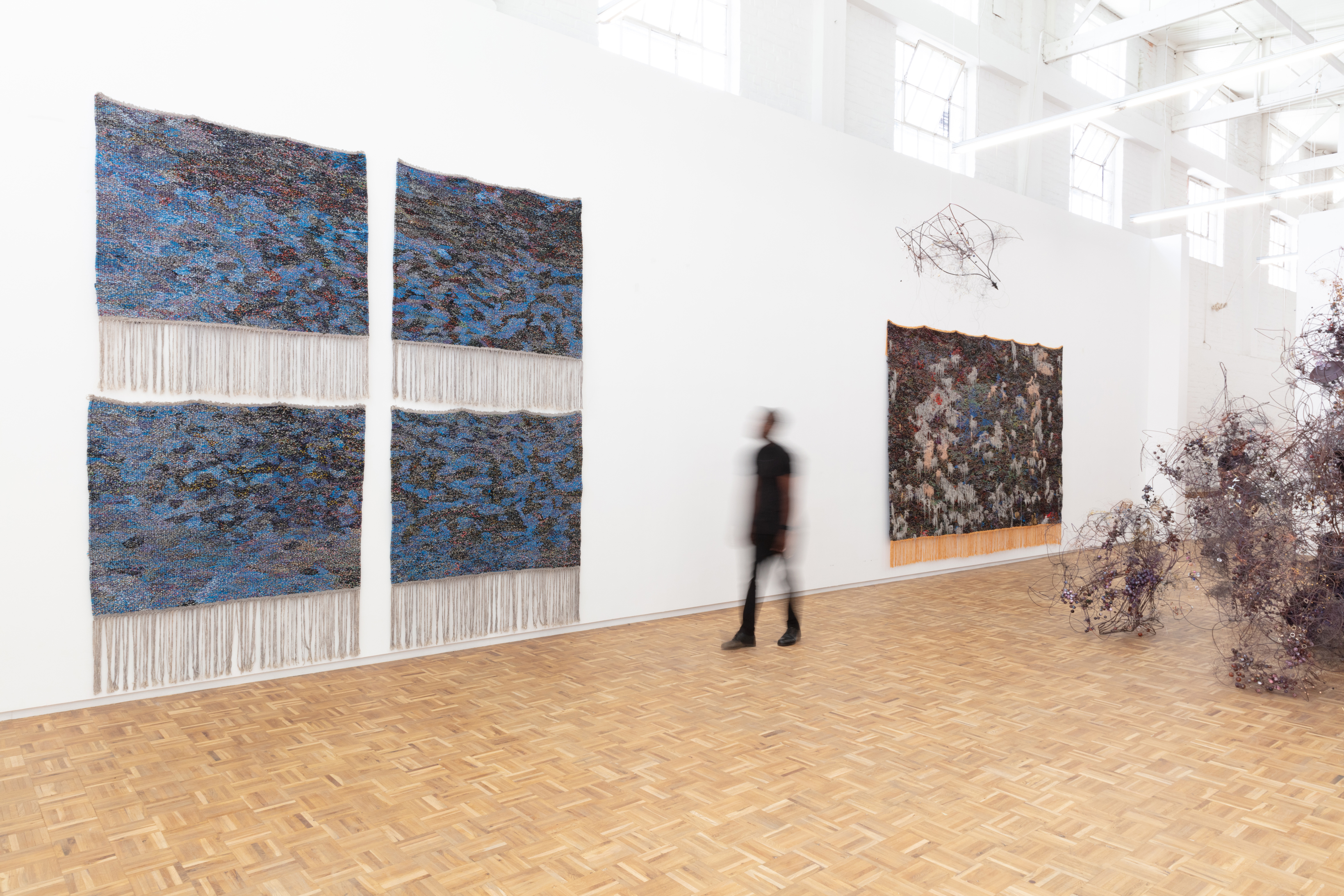
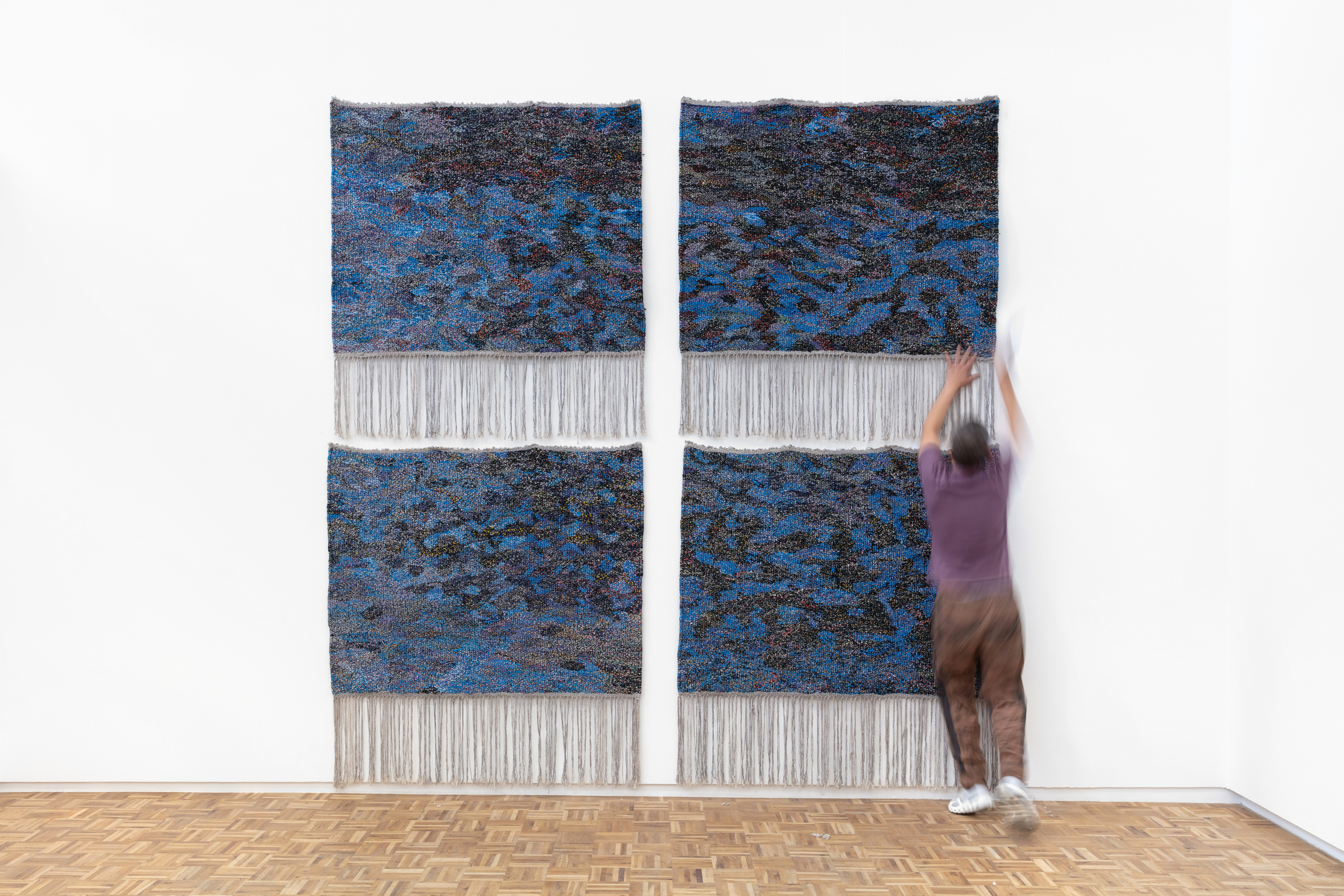

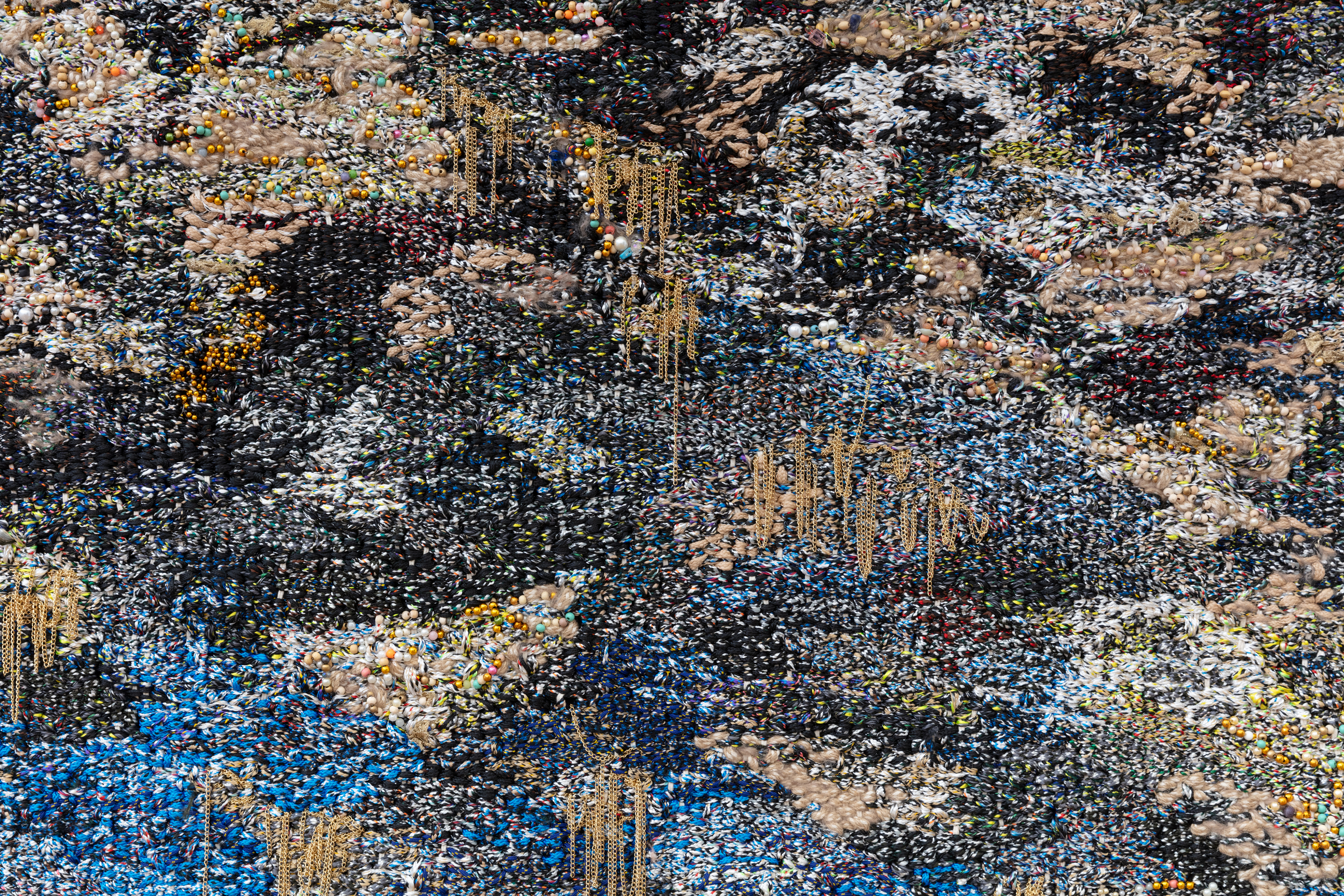
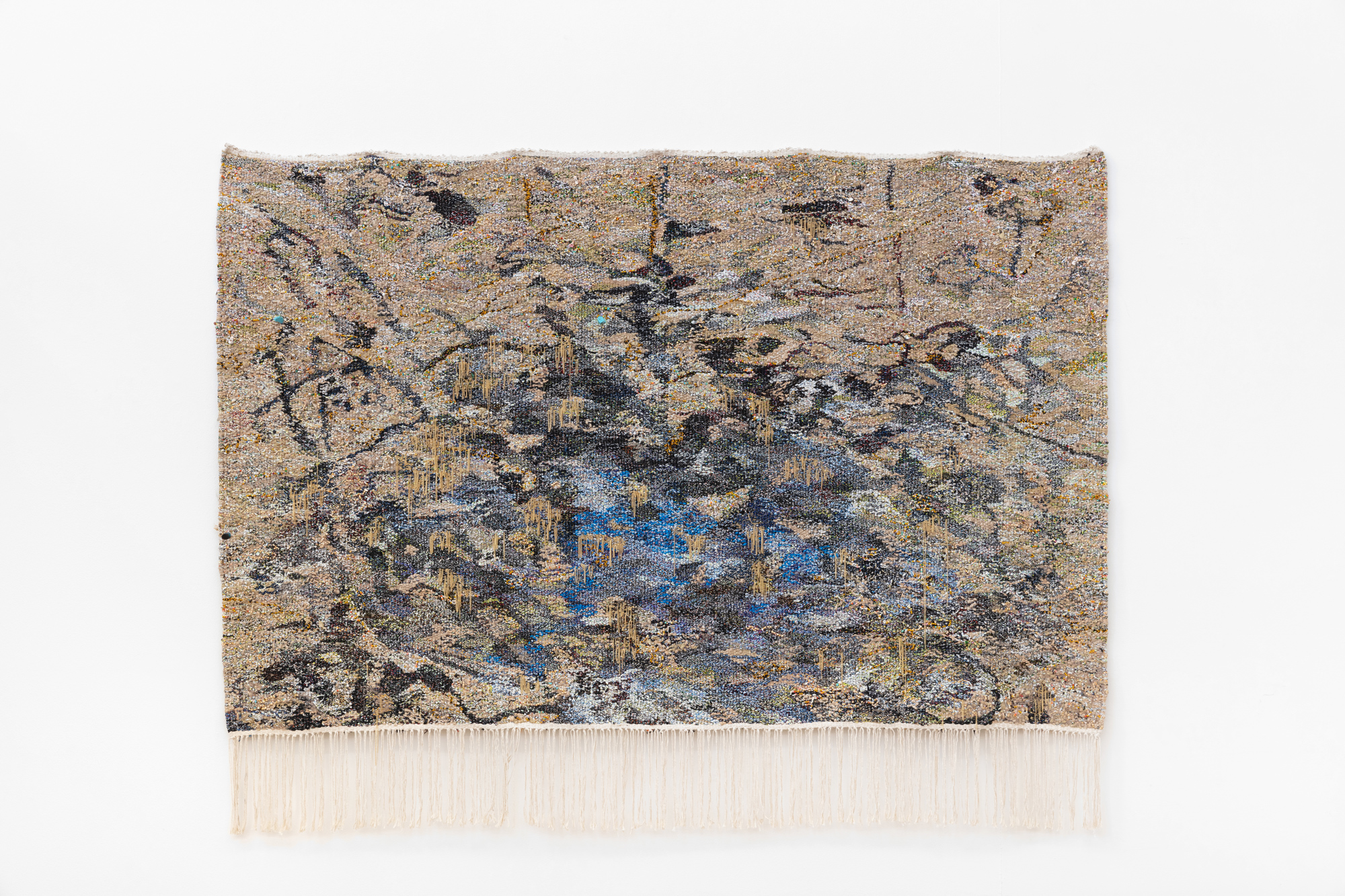


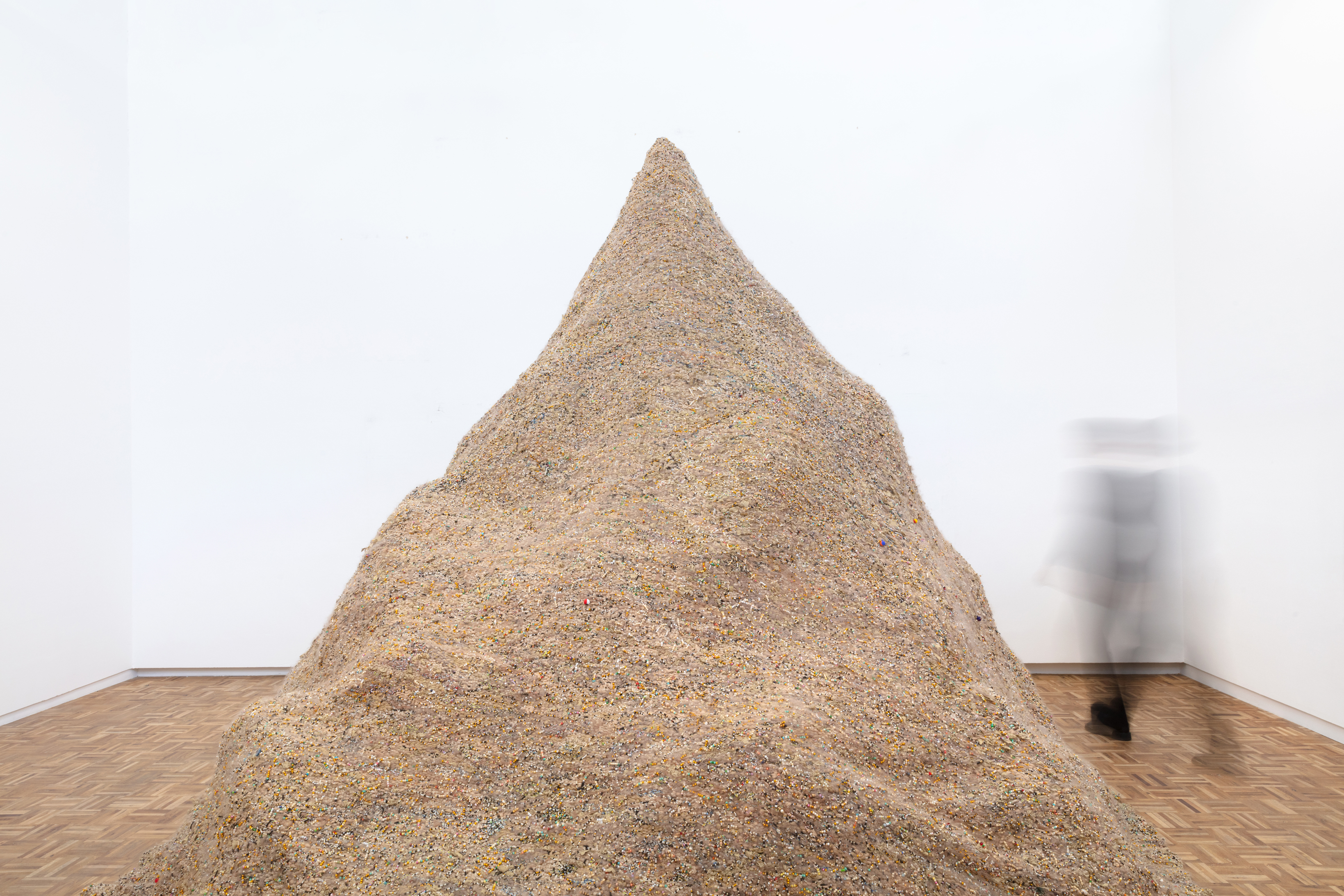
What, then, accounts for the mysterious intelligibility of artworks? This question seems to find expression directly and obliquely in Igshaan Adams’ new body of work aptly titled Holy Terrain (2024). As with recent showings – Weerhoud (2024), Lynloop (2024), Primêre Wentelbaan (2023), Vastrapplek (2022) and Desire Lines (2022) – this offering has a distinct weight, a comportment that narrates his search for a meaningful space where the body, indeed the self, can dwell purposefully. In this exhibition, Adams inaugurates a line of questioning that concedes our precariousness to the multiple ways in which we inhabit the world – the ways in which the self can be sanctified anew amidst all sorts of existential harms.
Composed of no less than fifteen artworks, there is in this oeuvre, much like in the previous exhibitions, the ever-present and ever-morphing feature of materiality that operates parallel to a thematic breadth that encircles this work. In a palpable sense, Adams’ work exalts and recalibrates an age-old modernist tenet that insists on a “truth to materials” – a sensibility that emboldens the essence of materials as opposed to its concealment. Materiality for Adams simultaneously bears a distinct aesthetic, ideological, and political function. It is the nodal point where the use of linoleum, beads, thread, wire, cotton twine and fabric coalesce with their deep excavations into themes of spirituality, cultural identity, queerness, and ecological crisis. In this assemblage of possibilities and points of departure brought to life through his inventive use of materials, what then emerges is what we might think of as a continuous surface that is characterized by different textures of formal and conceptual complexity.
At once curious and remarkable is Adams’ poeticization of everything, most notably the very production of the works, which entails a process that begins with an ambition; indeed an inclination towards an egalitarian way of art making and thinking. What is so neatly hidden in Adams’ process is the fiction of distance between himself and the team he composes the works with. In this dynamic, we observe a sustained gesturing towards a ‘scenius’: that which simultaneously disrupts the normativity of sole authorship while empowering the abilities, creative energies, and intelligence of a group. Adams, we can say with certainty, comfortably draws upon the intelligence of the collective. What ensues is a conceptual and formal conversation with his interlocutors to reimagine thoughts, forms, motifs, and politics that reverberate between selves in an effort to restate that while the personal is political, it is, lest we forget, also communal. Thus, when we see the sheets of linoleum being marked with bodily traces, when we encounter intensities of colour emerging on multiple surfaces, when we observe the dialogue between the cartographic renderings and woven mountains, we are called to reflect upon the eventness that precedes the objects. As such, the works function as constituents of a larger unfolding between persons partaking in Adams’ art making. Accordingly, as the collective thinking and making indicates the investiture of a specific register in Adams’ way of working, it becomes apparent that the sites of meaning lie not only in the artworks themselves but equally in the way in which they are imagined, (per)formed, and weaved into existence through a dialogic engagement. It is for this reason that the cartography of Holy Terrain is as focused as it is eclectic.
Adams renders sacrosanct the intimacy between the works, their making, and their extrinsic significance. This is crucial to make known in order to comprehend the deconstructive nature of this body of work where it reflects upon its own formation and its social performativity in society. Not only is this where Adams invites us to reckon with the beauty and ugliness of the world but it is also where he opens a disparate line of inquiry that resembles the non-linear manner of his works. Here Adams is concerned with multiple themes, all intersecting at once: dreamscapes as spiritual and aesthetic resources; our interiorities as shaped by ourselves and the environments we inhabit, determining paths yet to be defined; what the body is holding onto and what it excretes; and how the body can begin a somatological endeavour to formulate epistemologies of and from itself. In a sense, Adams’ process lends itself to a kind of cubist thinking that attempts to engage multiple perspectives simultaneously although their anchor remains intact. It is through this logic that Adams ultimately recentres the body, indeed the self, and immerses it in, as it were, a Holy Terrain.
…
Holy Terrain is the artist’s seventh solo exhibition with the gallery.
Composed of no less than fifteen artworks, there is in this oeuvre, much like in the previous exhibitions, the ever-present and ever-morphing feature of materiality that operates parallel to a thematic breadth that encircles this work. In a palpable sense, Adams’ work exalts and recalibrates an age-old modernist tenet that insists on a “truth to materials” – a sensibility that emboldens the essence of materials as opposed to its concealment. Materiality for Adams simultaneously bears a distinct aesthetic, ideological, and political function. It is the nodal point where the use of linoleum, beads, thread, wire, cotton twine and fabric coalesce with their deep excavations into themes of spirituality, cultural identity, queerness, and ecological crisis. In this assemblage of possibilities and points of departure brought to life through his inventive use of materials, what then emerges is what we might think of as a continuous surface that is characterized by different textures of formal and conceptual complexity.
At once curious and remarkable is Adams’ poeticization of everything, most notably the very production of the works, which entails a process that begins with an ambition; indeed an inclination towards an egalitarian way of art making and thinking. What is so neatly hidden in Adams’ process is the fiction of distance between himself and the team he composes the works with. In this dynamic, we observe a sustained gesturing towards a ‘scenius’: that which simultaneously disrupts the normativity of sole authorship while empowering the abilities, creative energies, and intelligence of a group. Adams, we can say with certainty, comfortably draws upon the intelligence of the collective. What ensues is a conceptual and formal conversation with his interlocutors to reimagine thoughts, forms, motifs, and politics that reverberate between selves in an effort to restate that while the personal is political, it is, lest we forget, also communal. Thus, when we see the sheets of linoleum being marked with bodily traces, when we encounter intensities of colour emerging on multiple surfaces, when we observe the dialogue between the cartographic renderings and woven mountains, we are called to reflect upon the eventness that precedes the objects. As such, the works function as constituents of a larger unfolding between persons partaking in Adams’ art making. Accordingly, as the collective thinking and making indicates the investiture of a specific register in Adams’ way of working, it becomes apparent that the sites of meaning lie not only in the artworks themselves but equally in the way in which they are imagined, (per)formed, and weaved into existence through a dialogic engagement. It is for this reason that the cartography of Holy Terrain is as focused as it is eclectic.
Adams renders sacrosanct the intimacy between the works, their making, and their extrinsic significance. This is crucial to make known in order to comprehend the deconstructive nature of this body of work where it reflects upon its own formation and its social performativity in society. Not only is this where Adams invites us to reckon with the beauty and ugliness of the world but it is also where he opens a disparate line of inquiry that resembles the non-linear manner of his works. Here Adams is concerned with multiple themes, all intersecting at once: dreamscapes as spiritual and aesthetic resources; our interiorities as shaped by ourselves and the environments we inhabit, determining paths yet to be defined; what the body is holding onto and what it excretes; and how the body can begin a somatological endeavour to formulate epistemologies of and from itself. In a sense, Adams’ process lends itself to a kind of cubist thinking that attempts to engage multiple perspectives simultaneously although their anchor remains intact. It is through this logic that Adams ultimately recentres the body, indeed the self, and immerses it in, as it were, a Holy Terrain.
Text by Dr. Thabang Monoa
University of Cape Town
University of Cape Town
…
Holy Terrain is the artist’s seventh solo exhibition with the gallery.


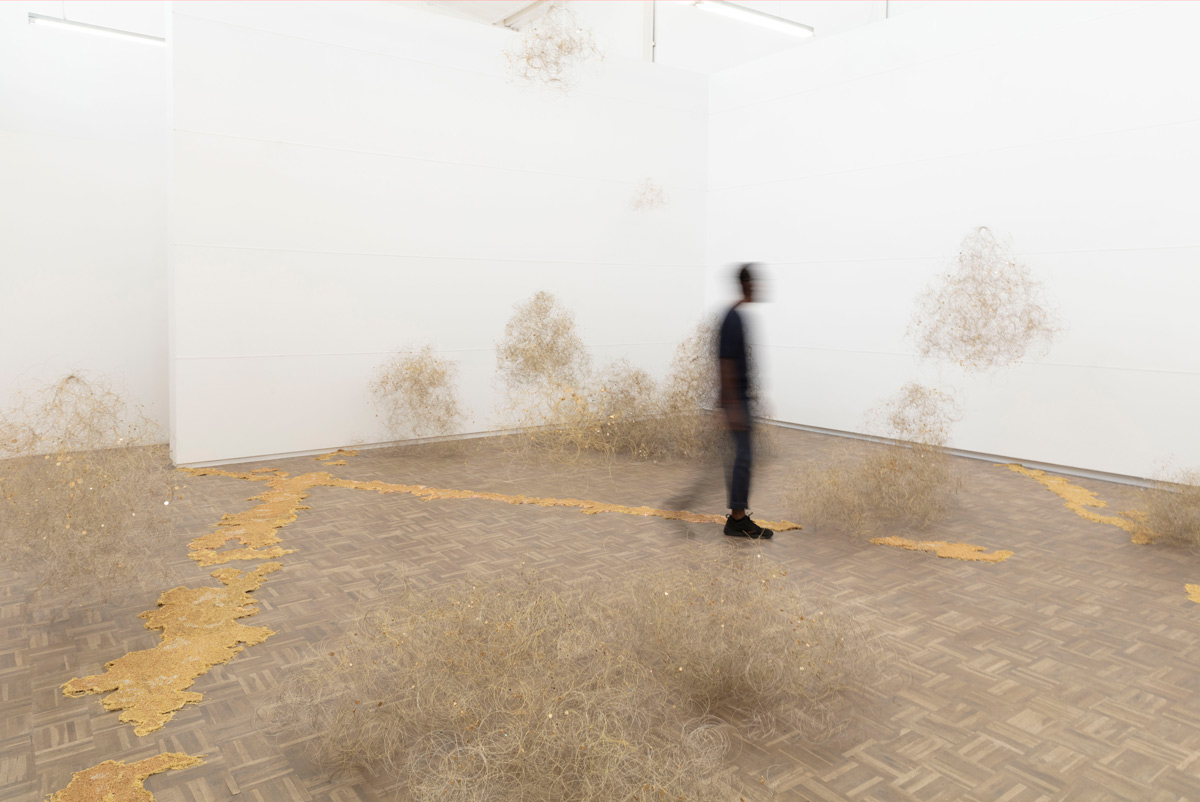








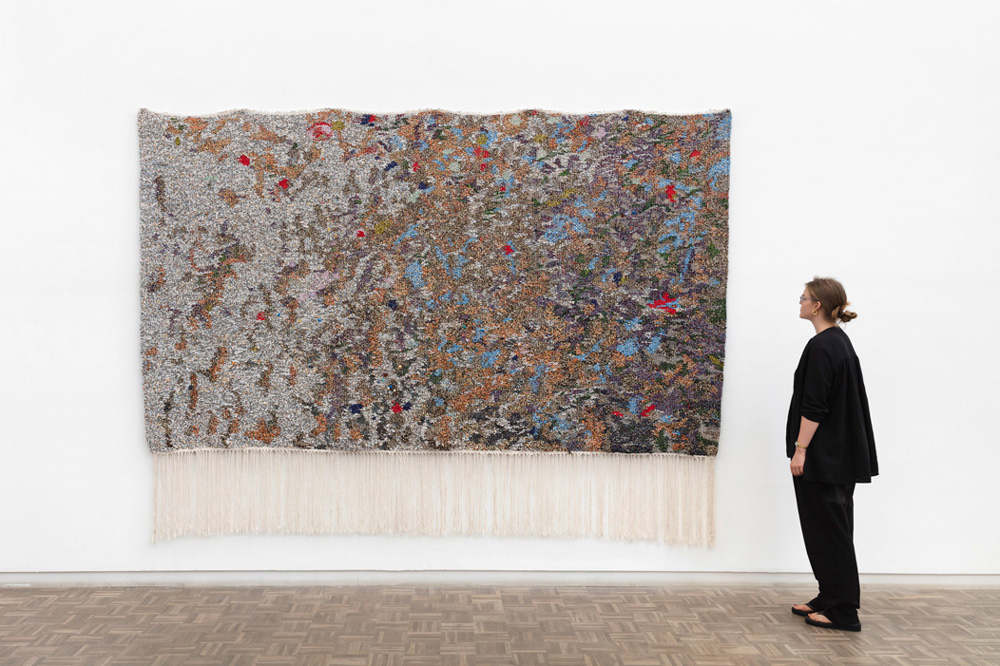



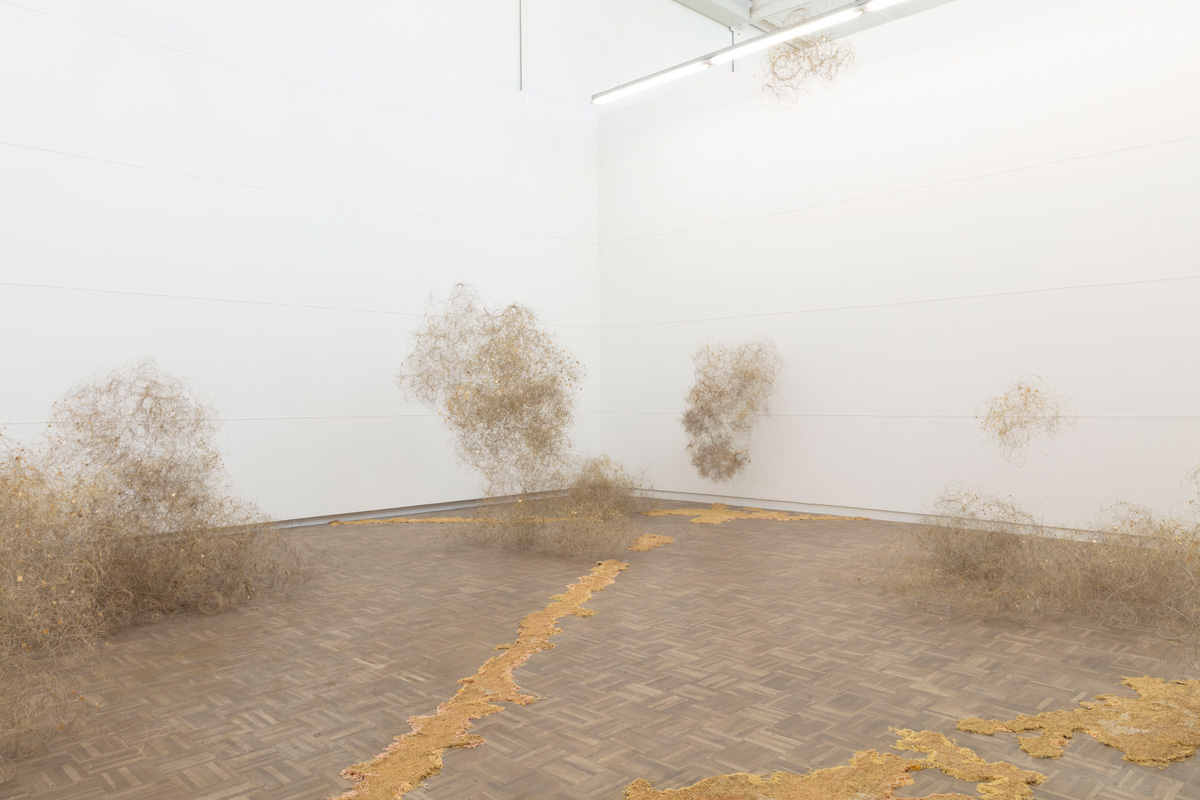

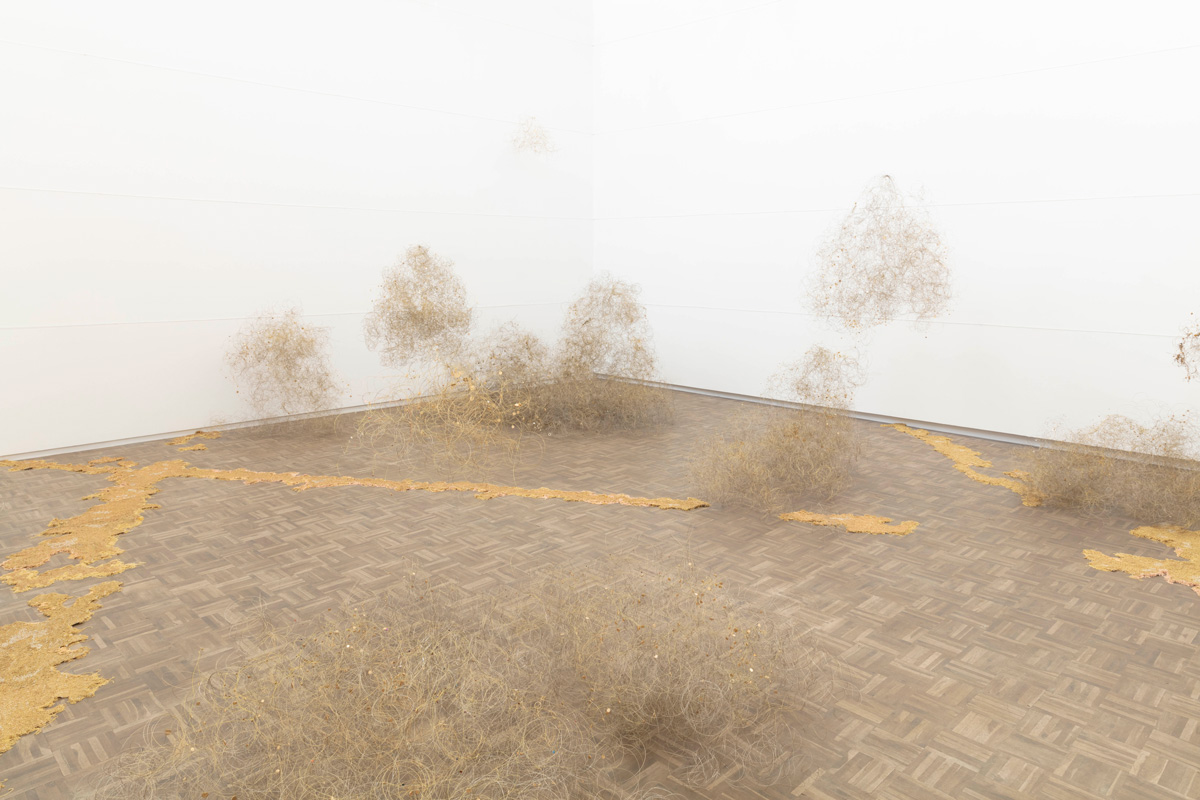
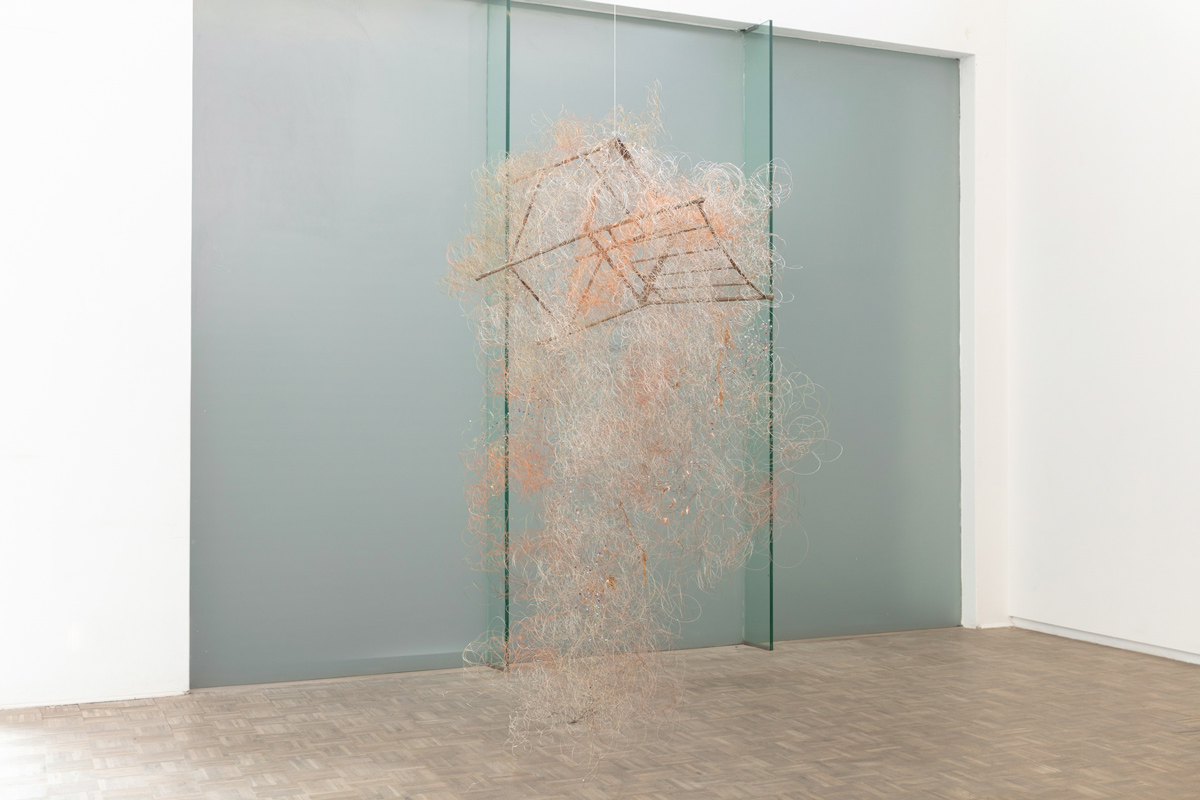

skarrelbaan
poem by Jitsvinger
‘n Meganiese god staar uit die hemel af
Op ôs’se groen marble
Zoom in en verdwaal maar bly ingeskakel
Kop in ‘n Google cloud
Voete op ‘n skarrelbaan
Soeke na vergete roetes
‘n Beter toekoms vol
Tênk punctured deur’ie speedometer se naald
Uber driver zoom oor’ie grid en stoot
‘n Carbon footprint oppie carpet van Moeder Aarde
Vinyl tapyt slang seil deur’ie gang tot na die voorkamer
Vang spore vas in patrone unique in elke
Household vertel ‘n storie
Mites sny die kortpad
Na die smokkelhuis oor die veld
Tussen debris te bespeur
Onder die straatlig gloei ‘n boeiende verhaal
Op paaie onbekend
Gemerk deur desires
Unfulfilled
Sak daai rol soes ‘n smous se pryse
Rafel uit oorie mat
Signs vannie tye
Die Maker weef garing en stof uit jou werklikheid
Maal die gees van staalwol tot satyn fyn
Mondsketse klank die contours waar ondekkers reis
Spore ets in tyd met woord en dialect oorkruis
In teksboek leefstyl riglyn in madrassa
Distrik ses strik getrek
Dis wit of weg met die massas
Remind my begin die hoofstuk
Highways deur’ie verstand sny oor’ie N1
Vanguard Drive verby Bontas tot in Namakwaland
Bloed deur’ie are van my
Hoekstaander vang lyn
Besoekers raak gelank tuis
Stranger raak bekend
Umbilical straat verryk jou
Om te stap is meditasie
Genees jouself deur te wandel
Padtekens weerkaats ‘n verlede innie voorkant
Elke porsie geselskap is
Padkos suspend die lang pad
Bepeins
Change die narrative sê die hand wat
Jou lewe se chapter skryf
Buig die knieë oppie mat
Stuur prayer clouds vol needs & wants
In ‘n dans met die siel se eternal partner
Sirkel terug na die physical te swak
Kop innie lig voet oppie grond
Skop teen die klip van soek na genot
In ‘n spiritual cul-de-sac
Lyne oppie hand expose die pad na jou skatkis
‘n Origami oopgevou se geheim word verklap
Golwe vee oor’ie strand van jou geheue
Spore op sand is gemaak van plesier
Vingerpunt volg die lyn
Die innerlike vertolk die travel
Slinger deur’ie fynbos
Skink uit die rymte
Vol is die vessel
Spiral deur die lesse van elders
Patterns is instrumental
Sleutels twist en ontlok
‘n Nuwe wentelbaan
Jitsvinger is an Afrikaaps vernacular performer from Cape Town who combines rap, poetry, self-composed music, theatre and storytelling to give his observations on issues concerning heritage, culture and especially the Afrikaans language.
...
blank is pleased to announce skarrelbaan, a solo exhibition by Igshaan Adams.
An Afrikaans colloquialism in the Kaaps (Cape) dialect, the exhibition title is a phrase that refuses translation. Referring to a particular way of moving through the world with a wary desperation to improve one’s circumstances, to be on the skarrelbaan is to be on the lookout for good fortune; hustling for jobs, money, or food.
Comprising a series of new large-scale weavings and installation, the exhibition expands on the artist’s investigations of ‘desire lines’, those paths walked into the landscape that circumvent or resist spatial planning. In Cape Town, this resistance to the confines of organised space holds a special poignancy; one of the enduring evils of Apartheid is the physical segregation and economic exclusion of people of colour by means of boundaries, highways and veld (open ground). The paths that traverse these spaces describe the journeys of people, led by intuition or necessity, in search of work and community.
Working with satellite imagery to create motifs for his tapestries, Adams invites us to witness these collective histories from above. Weaving their stories into the works on show, he transforms commonplace materials such as recycled nylon rope, string, wire and beads into precious objects.
Much like the pathways trampled into vinyl flooring tell the personal histories of a domestic space so too do these desire paths, at hundreds of times the scale, record the daily pursuits of individuals and communities.
Extending across one room of the gallery is an installation of wire sculptures that hover above a network of pathways woven out of fine gold chain. The wire ‘prayer clouds’, as Adams refers to them, represent the notion that the hopes and aspirations we send upwards to heaven could become caught, trapped in the clouds on their way to their intended destination. Adams’s clouds glint and flicker with embellishments; the glimmers of hope made tangible. They also recall the dust clouds of the rieldans, a traditional dance of courtship (desire) involving fast footwork that leaves dust from the ground suspended in the air. The grounded weightiness of the woven pathways, the lightness of the clouds, and the visual tension between the two reminds us of what it is to have one’s feet on the ground and head in the clouds.
...
Through this tracing of pathways throughout the exhibition, an imagined figure is conjured up, walking their own desire path. Her gait - know him by his gait - is determined; pursuing. Even as she walks the hard terrain, her thoughts are full of dreams and visions of success. Kop in ‘n Google cloud, voete op ‘n skarrelbaan.
…
skarrelbaan is the artist’s sixth exhibition with the gallery.
poem by Jitsvinger
‘n Meganiese god staar uit die hemel af
Op ôs’se groen marble
Zoom in en verdwaal maar bly ingeskakel
Kop in ‘n Google cloud
Voete op ‘n skarrelbaan
Soeke na vergete roetes
‘n Beter toekoms vol
Tênk punctured deur’ie speedometer se naald
Uber driver zoom oor’ie grid en stoot
‘n Carbon footprint oppie carpet van Moeder Aarde
Vinyl tapyt slang seil deur’ie gang tot na die voorkamer
Vang spore vas in patrone unique in elke
Household vertel ‘n storie
Mites sny die kortpad
Na die smokkelhuis oor die veld
Tussen debris te bespeur
Onder die straatlig gloei ‘n boeiende verhaal
Op paaie onbekend
Gemerk deur desires
Unfulfilled
Sak daai rol soes ‘n smous se pryse
Rafel uit oorie mat
Signs vannie tye
Die Maker weef garing en stof uit jou werklikheid
Maal die gees van staalwol tot satyn fyn
Mondsketse klank die contours waar ondekkers reis
Spore ets in tyd met woord en dialect oorkruis
In teksboek leefstyl riglyn in madrassa
Distrik ses strik getrek
Dis wit of weg met die massas
Remind my begin die hoofstuk
Highways deur’ie verstand sny oor’ie N1
Vanguard Drive verby Bontas tot in Namakwaland
Bloed deur’ie are van my
Hoekstaander vang lyn
Besoekers raak gelank tuis
Stranger raak bekend
Umbilical straat verryk jou
Om te stap is meditasie
Genees jouself deur te wandel
Padtekens weerkaats ‘n verlede innie voorkant
Elke porsie geselskap is
Padkos suspend die lang pad
Bepeins
Change die narrative sê die hand wat
Jou lewe se chapter skryf
Buig die knieë oppie mat
Stuur prayer clouds vol needs & wants
In ‘n dans met die siel se eternal partner
Sirkel terug na die physical te swak
Kop innie lig voet oppie grond
Skop teen die klip van soek na genot
In ‘n spiritual cul-de-sac
Lyne oppie hand expose die pad na jou skatkis
‘n Origami oopgevou se geheim word verklap
Golwe vee oor’ie strand van jou geheue
Spore op sand is gemaak van plesier
Vingerpunt volg die lyn
Die innerlike vertolk die travel
Slinger deur’ie fynbos
Skink uit die rymte
Vol is die vessel
Spiral deur die lesse van elders
Patterns is instrumental
Sleutels twist en ontlok
‘n Nuwe wentelbaan
Jitsvinger is an Afrikaaps vernacular performer from Cape Town who combines rap, poetry, self-composed music, theatre and storytelling to give his observations on issues concerning heritage, culture and especially the Afrikaans language.
...
blank is pleased to announce skarrelbaan, a solo exhibition by Igshaan Adams.
An Afrikaans colloquialism in the Kaaps (Cape) dialect, the exhibition title is a phrase that refuses translation. Referring to a particular way of moving through the world with a wary desperation to improve one’s circumstances, to be on the skarrelbaan is to be on the lookout for good fortune; hustling for jobs, money, or food.
Comprising a series of new large-scale weavings and installation, the exhibition expands on the artist’s investigations of ‘desire lines’, those paths walked into the landscape that circumvent or resist spatial planning. In Cape Town, this resistance to the confines of organised space holds a special poignancy; one of the enduring evils of Apartheid is the physical segregation and economic exclusion of people of colour by means of boundaries, highways and veld (open ground). The paths that traverse these spaces describe the journeys of people, led by intuition or necessity, in search of work and community.
Working with satellite imagery to create motifs for his tapestries, Adams invites us to witness these collective histories from above. Weaving their stories into the works on show, he transforms commonplace materials such as recycled nylon rope, string, wire and beads into precious objects.
Much like the pathways trampled into vinyl flooring tell the personal histories of a domestic space so too do these desire paths, at hundreds of times the scale, record the daily pursuits of individuals and communities.
Extending across one room of the gallery is an installation of wire sculptures that hover above a network of pathways woven out of fine gold chain. The wire ‘prayer clouds’, as Adams refers to them, represent the notion that the hopes and aspirations we send upwards to heaven could become caught, trapped in the clouds on their way to their intended destination. Adams’s clouds glint and flicker with embellishments; the glimmers of hope made tangible. They also recall the dust clouds of the rieldans, a traditional dance of courtship (desire) involving fast footwork that leaves dust from the ground suspended in the air. The grounded weightiness of the woven pathways, the lightness of the clouds, and the visual tension between the two reminds us of what it is to have one’s feet on the ground and head in the clouds.
...
Through this tracing of pathways throughout the exhibition, an imagined figure is conjured up, walking their own desire path. Her gait - know him by his gait - is determined; pursuing. Even as she walks the hard terrain, her thoughts are full of dreams and visions of success. Kop in ‘n Google cloud, voete op ‘n skarrelbaan.
…
skarrelbaan is the artist’s sixth exhibition with the gallery.
Igshaan Adams in conversation with Jitsvinger | blank projects, Cape Town



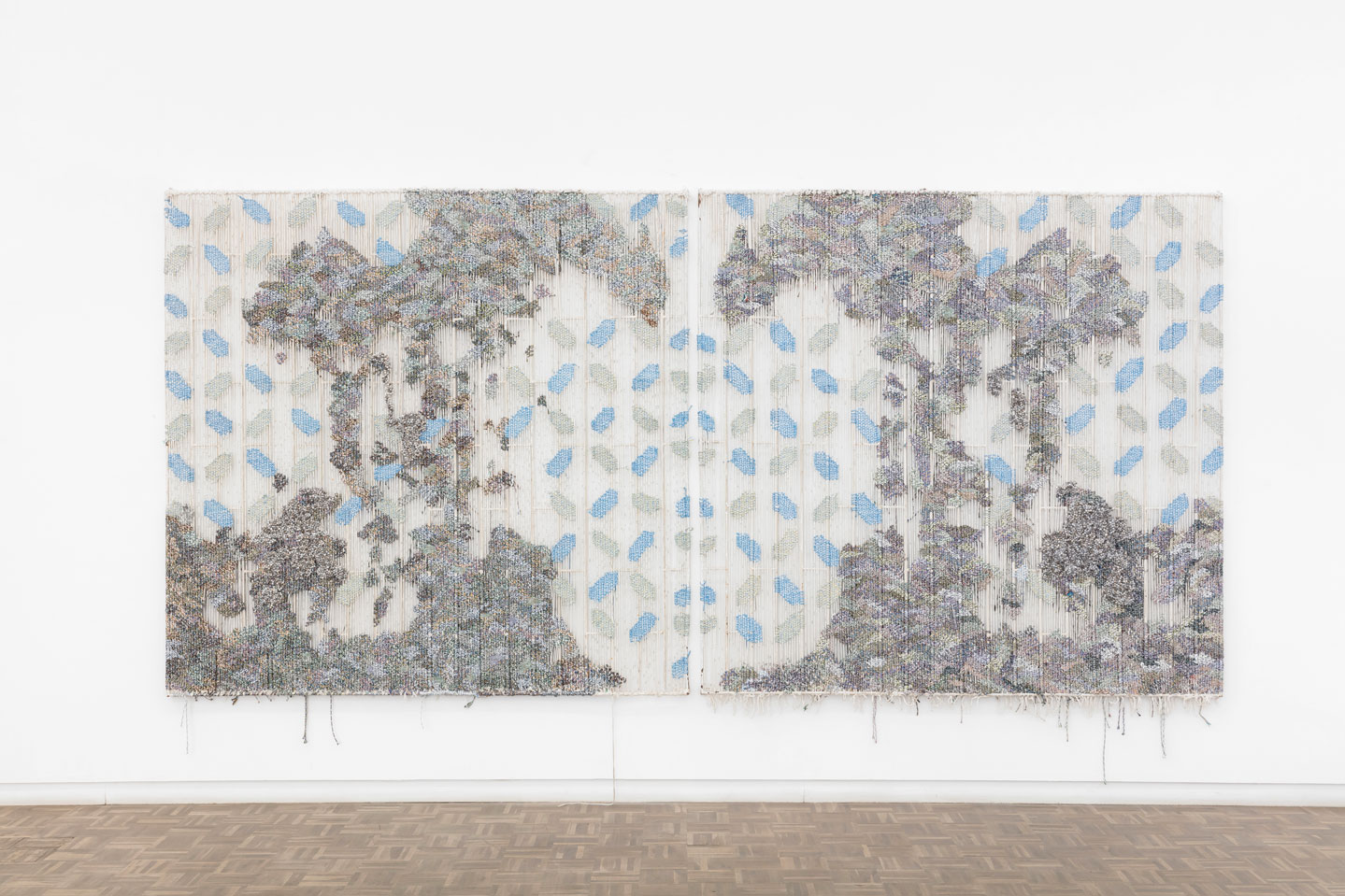

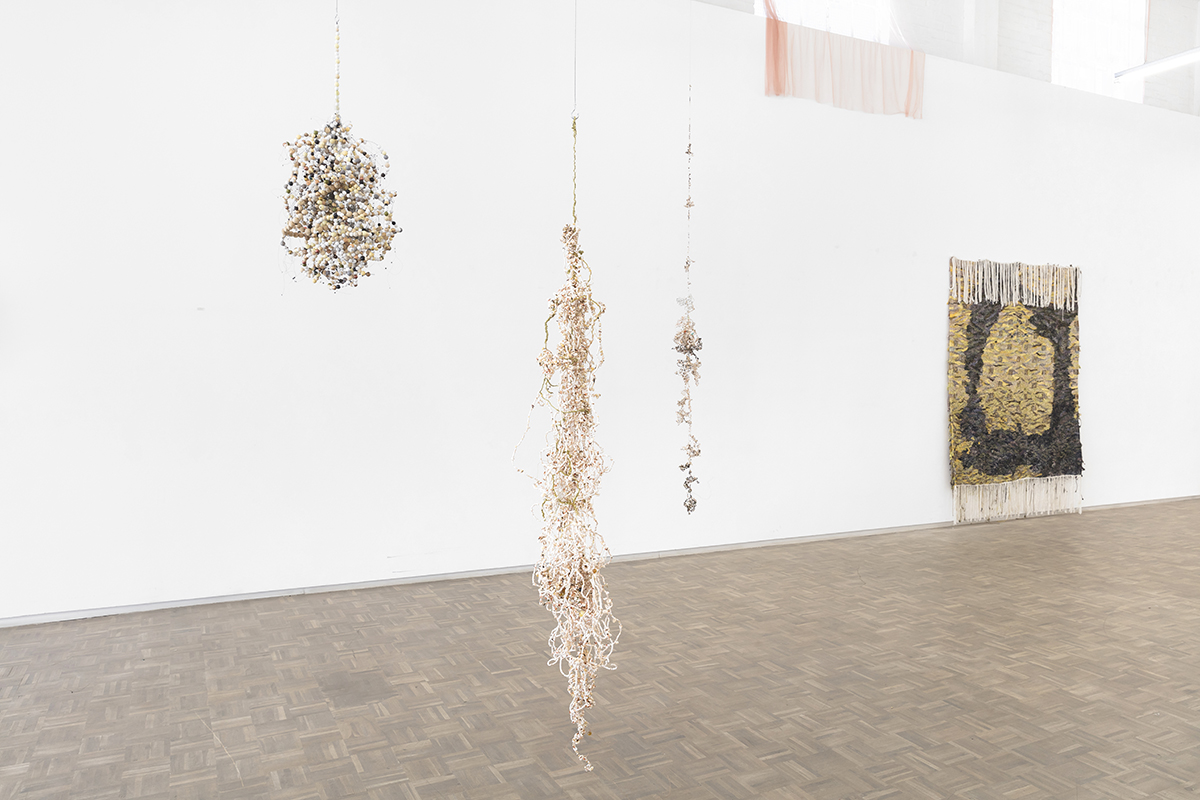








What Kalea of the Cape left in this World (1848)
One bed and accessories
One wardrobe
One ditto
One long and one short chest
Three paintings
A clock (defect)
Some kitchen tools
Three Tables
Seven assorted chairs
One bed and accessories
With the imprint of sound slumber
One wardrobe
Everything in its place
One ditto
Because sometimes you need more space
One long and one short chest
And the footsteps in-between
Three paintings
Glowing in the afternoon light
A clock (defect)
Op haar eie tyd
Some kitchen tools
To fill empty bellies
Three Tables
Plek vir almal by die tafel
Seven assorted chairs
For seven assorted friends
and their stukkende stories.
Yet all that remains is a piece of paper that records:
One bed and accessories
One wardrobe
One ditto
One long and one short chest
Three paintings
A clock (defect)
Some kitchen tools
Three Tables
Seven assorted chairs
*With some corrections by a great-great-great granddaughter.
Text by Saarah Jappie
According to the inventory of the Orphan Chamber of The Cape of Good Hope*
One bed and accessories
One wardrobe
One ditto
One long and one short chest
Three paintings
A clock (defect)
Some kitchen tools
Three Tables
Seven assorted chairs
One bed and accessories
With the imprint of sound slumber
One wardrobe
Everything in its place
One ditto
Because sometimes you need more space
One long and one short chest
And the footsteps in-between
Three paintings
Glowing in the afternoon light
A clock (defect)
Op haar eie tyd
Some kitchen tools
To fill empty bellies
Three Tables
Plek vir almal by die tafel
Seven assorted chairs
For seven assorted friends
and their stukkende stories.
Yet all that remains is a piece of paper that records:
One bed and accessories
One wardrobe
One ditto
One long and one short chest
Three paintings
A clock (defect)
Some kitchen tools
Three Tables
Seven assorted chairs
*With some corrections by a great-great-great granddaughter.
Text by Saarah Jappie

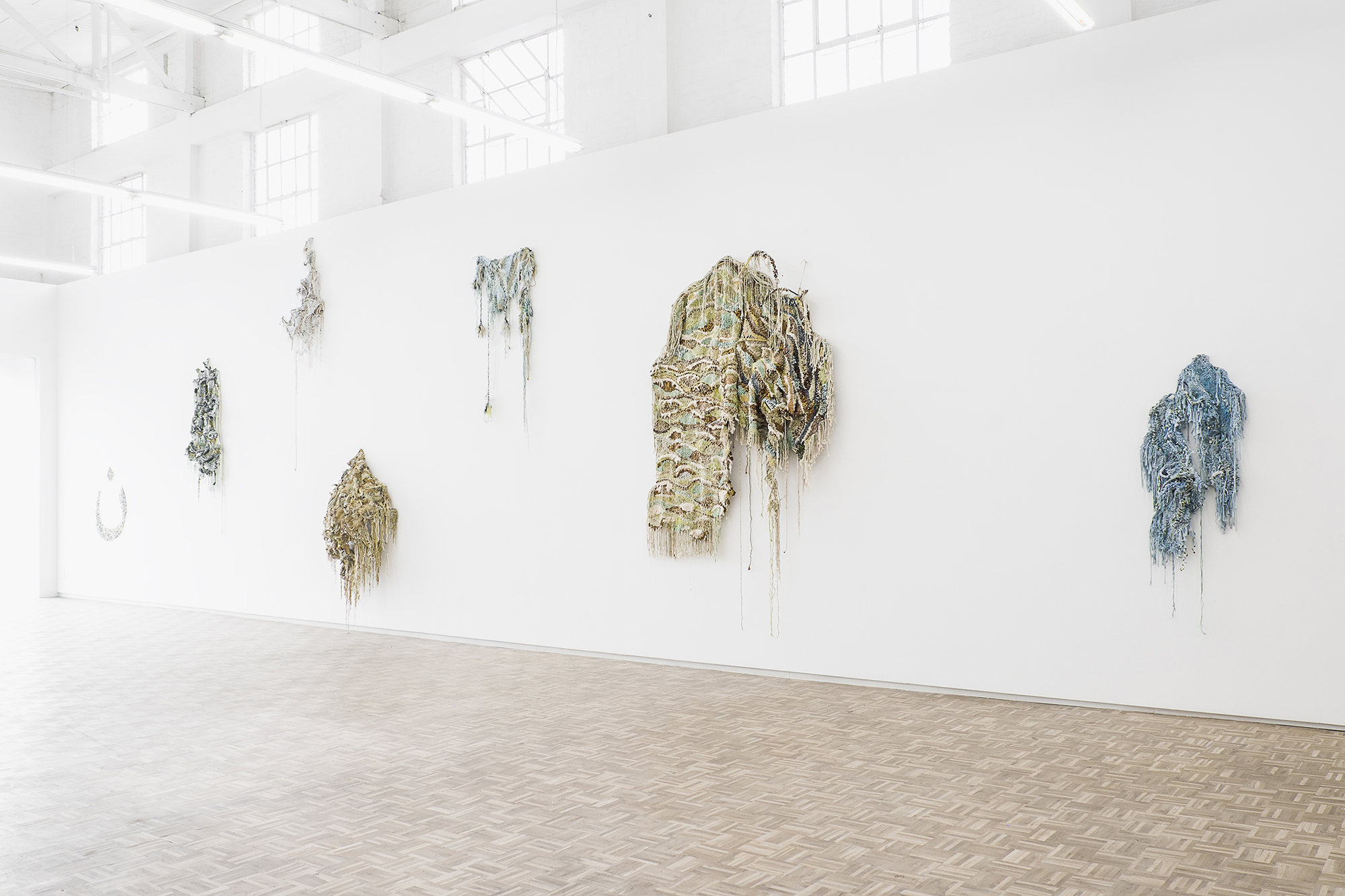















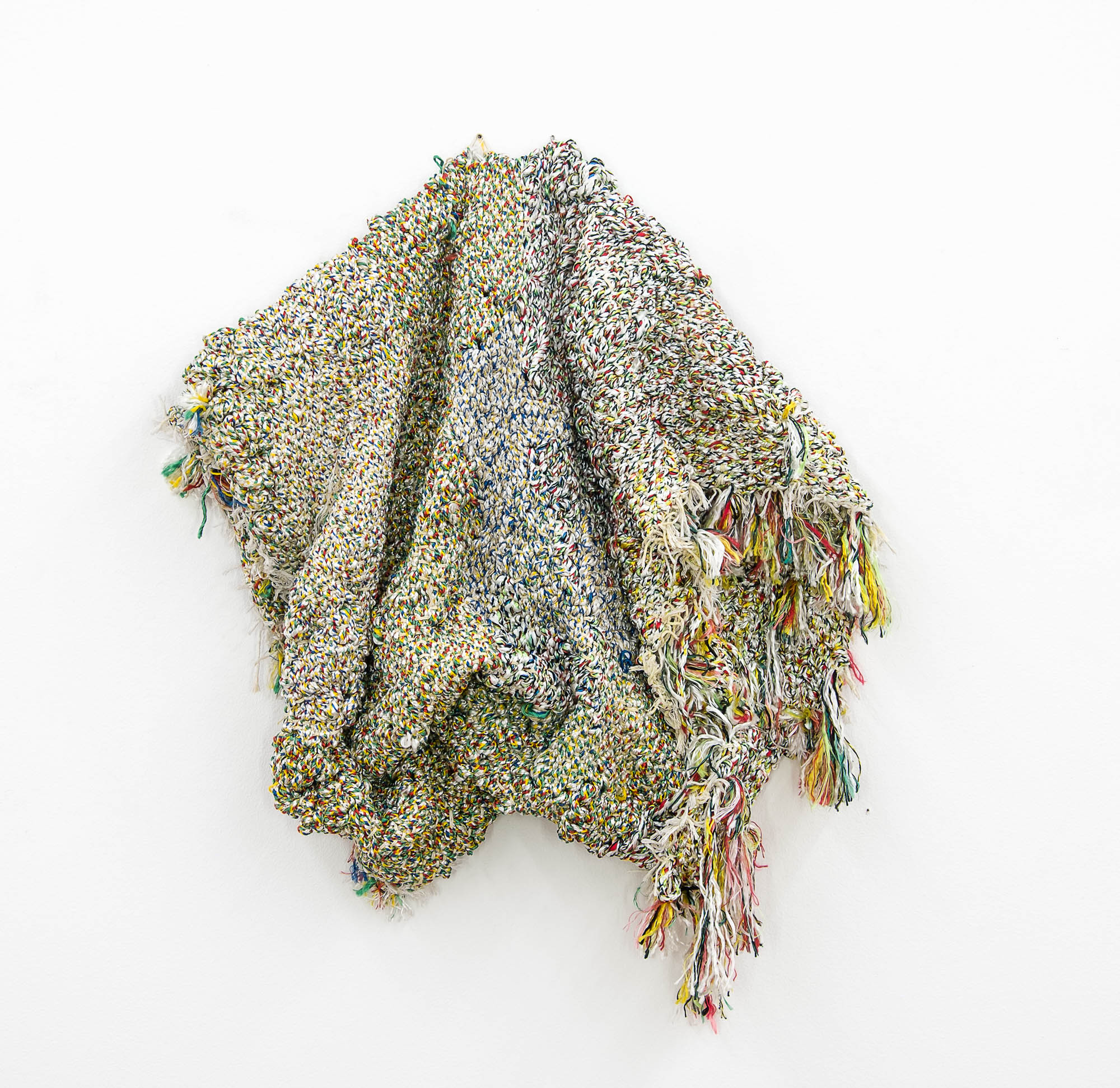

blank is proud to announce Al Latîf, a solo exhibition by Igshaan Adams.
In Al Latîf, Adams presents new configurations of process and material in a series of wall- and floor-based installations and tapestries, working both within his established vocabulary of abstraction as well as modes of representation found in his earlier practice.
The premise for the exhibition developed from the artist’s contemplation of the metaphysical questions of mysticism; concepts of the “unknowable”, and the notion that there is no singular, inherent truth to existence. Taken as a lens through which to read Adams’ latest body of work, the show’s title demonstrates the rootedness of the exhibition in the artist’s faith and interest in Sufism. Translated to mean “The Subtle One”, Al Latîf is one of the ninety-nine names attributed to God (Allah) and is used to describe qualities of refinement, subtlety and delicacy of expression and perception.
Apparent in a number of the works is the use of symbolic devices such as those present in some of Adams’ earlier works. The image of a rose is found in the focal piece of the exhibition, a large-scale floor-based installation made of multi-coloured glass and plastic beads. Here, the rose with its layers of petals among thorns acts as a symbol for the many veils that, according to Islam, separate us from true reality, while the potential for new life is contained within the enveloped seeds. In Adams’ depiction, the rose serves doubly as a visual metaphor for the universe, resembling a vortex-like image of celestial space.
In his more abstract, woven works, Adams revisits some of the processes from his previous exhibition, Oorskot. Mimicking organic, plant-like structures, these wall-based sculptures are caught in an ambiguous state of suspension between life and death, creation or decay. The theme of nature and the dynamic environment is carried through in his series of large tapestries that are woven in undulating waves of various blue and green synthetic materials, recalling sea- or landscapes respectively. This impression of movement is communicated through Adams’ use of texture and composition, and is integral to the overall sensorial experience of the exhibition. In accordance with Sufi beliefs, there is an attempt to align one’s body with the rhythm of the universe through the subtle, gentle movements that form part of meditational prayer, and it is this quality of movement that he seeks to evoke in his works.
Lord, I am the weaver of Thy Name;
I weave and reap the profit
Of inner rapport of thee.
I weave the cloth of Thy Name, O Lord.
I have firmly strung my loom
With ten hundred threads;
The sun and moon
I hold as my witness.
Endlessly I count Thy Name
And take it as my wages;
I gently deposit it
Within the lotus of my heart.
I am the weaver of Thy Name.
Surat and nirat are the two pegs
That hold the frame of my loom;
Thus I weave with care and discernment
The cloth of Thy Name.
– extract from a poem by the 15th century mystic, Kabir.
In Al Latîf, Adams presents new configurations of process and material in a series of wall- and floor-based installations and tapestries, working both within his established vocabulary of abstraction as well as modes of representation found in his earlier practice.
The premise for the exhibition developed from the artist’s contemplation of the metaphysical questions of mysticism; concepts of the “unknowable”, and the notion that there is no singular, inherent truth to existence. Taken as a lens through which to read Adams’ latest body of work, the show’s title demonstrates the rootedness of the exhibition in the artist’s faith and interest in Sufism. Translated to mean “The Subtle One”, Al Latîf is one of the ninety-nine names attributed to God (Allah) and is used to describe qualities of refinement, subtlety and delicacy of expression and perception.
Apparent in a number of the works is the use of symbolic devices such as those present in some of Adams’ earlier works. The image of a rose is found in the focal piece of the exhibition, a large-scale floor-based installation made of multi-coloured glass and plastic beads. Here, the rose with its layers of petals among thorns acts as a symbol for the many veils that, according to Islam, separate us from true reality, while the potential for new life is contained within the enveloped seeds. In Adams’ depiction, the rose serves doubly as a visual metaphor for the universe, resembling a vortex-like image of celestial space.
In his more abstract, woven works, Adams revisits some of the processes from his previous exhibition, Oorskot. Mimicking organic, plant-like structures, these wall-based sculptures are caught in an ambiguous state of suspension between life and death, creation or decay. The theme of nature and the dynamic environment is carried through in his series of large tapestries that are woven in undulating waves of various blue and green synthetic materials, recalling sea- or landscapes respectively. This impression of movement is communicated through Adams’ use of texture and composition, and is integral to the overall sensorial experience of the exhibition. In accordance with Sufi beliefs, there is an attempt to align one’s body with the rhythm of the universe through the subtle, gentle movements that form part of meditational prayer, and it is this quality of movement that he seeks to evoke in his works.
Lord, I am the weaver of Thy Name;
I weave and reap the profit
Of inner rapport of thee.
I weave the cloth of Thy Name, O Lord.
I have firmly strung my loom
With ten hundred threads;
The sun and moon
I hold as my witness.
Endlessly I count Thy Name
And take it as my wages;
I gently deposit it
Within the lotus of my heart.
I am the weaver of Thy Name.
Surat and nirat are the two pegs
That hold the frame of my loom;
Thus I weave with care and discernment
The cloth of Thy Name.
– extract from a poem by the 15th century mystic, Kabir.
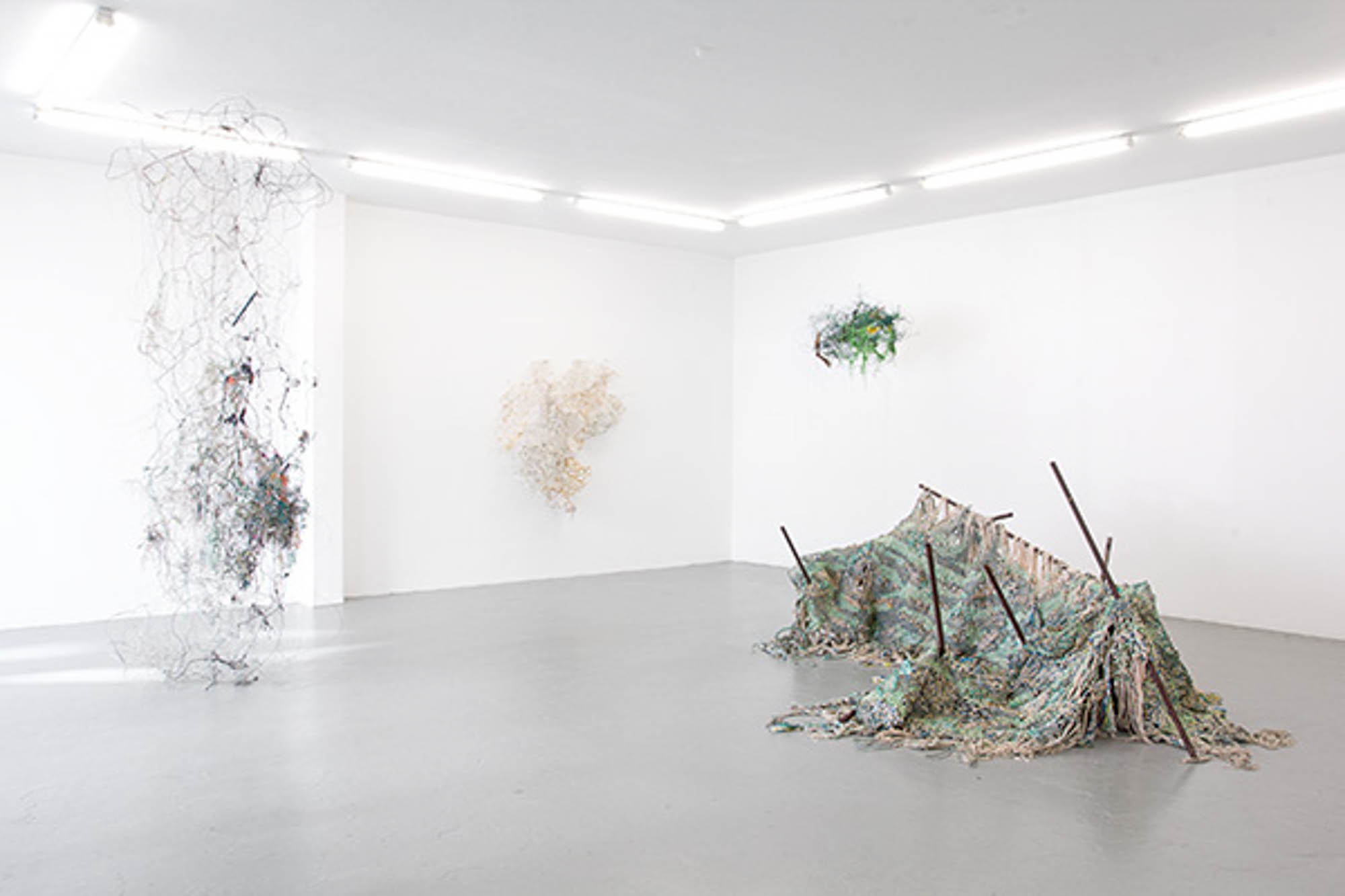
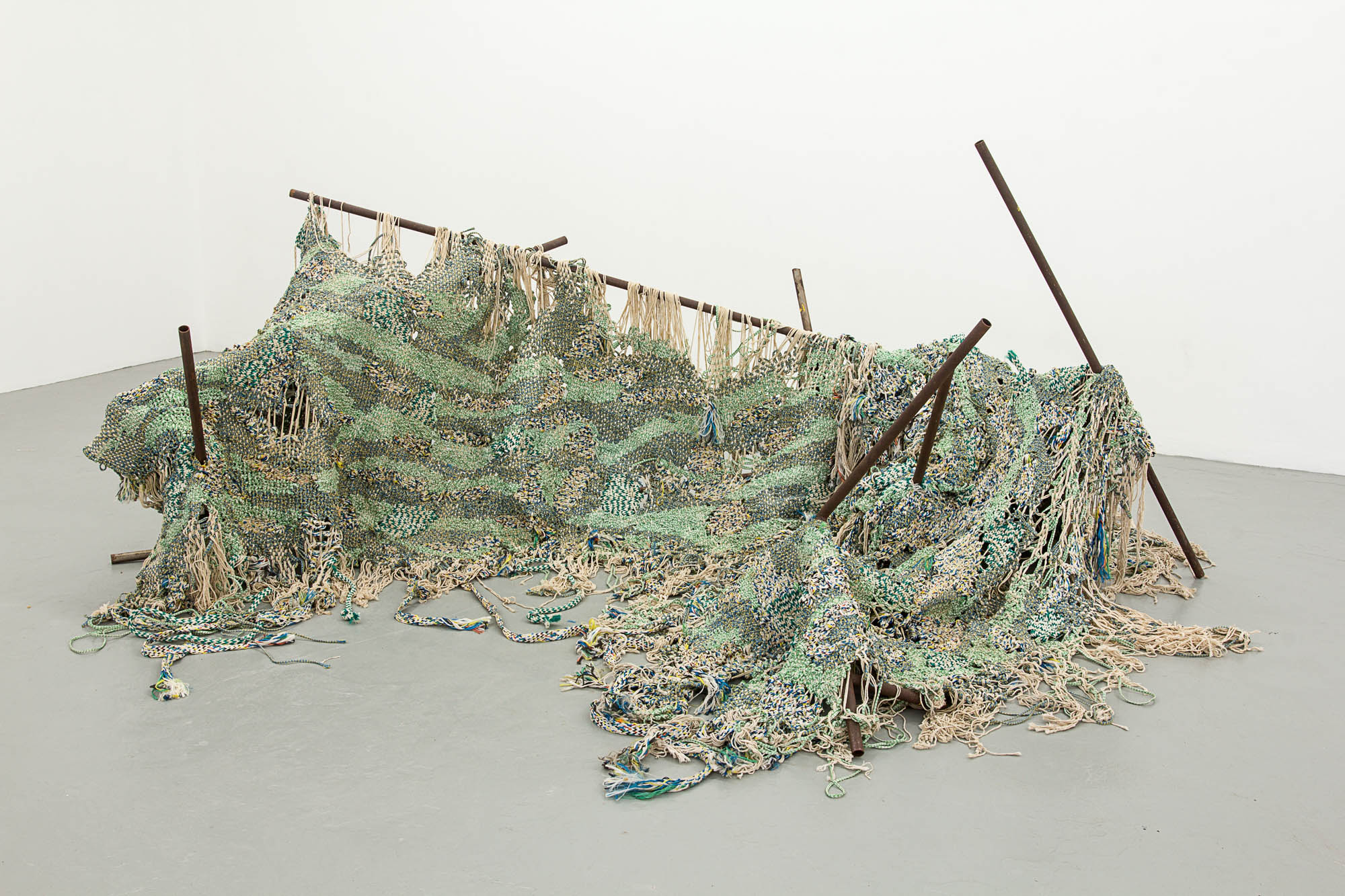








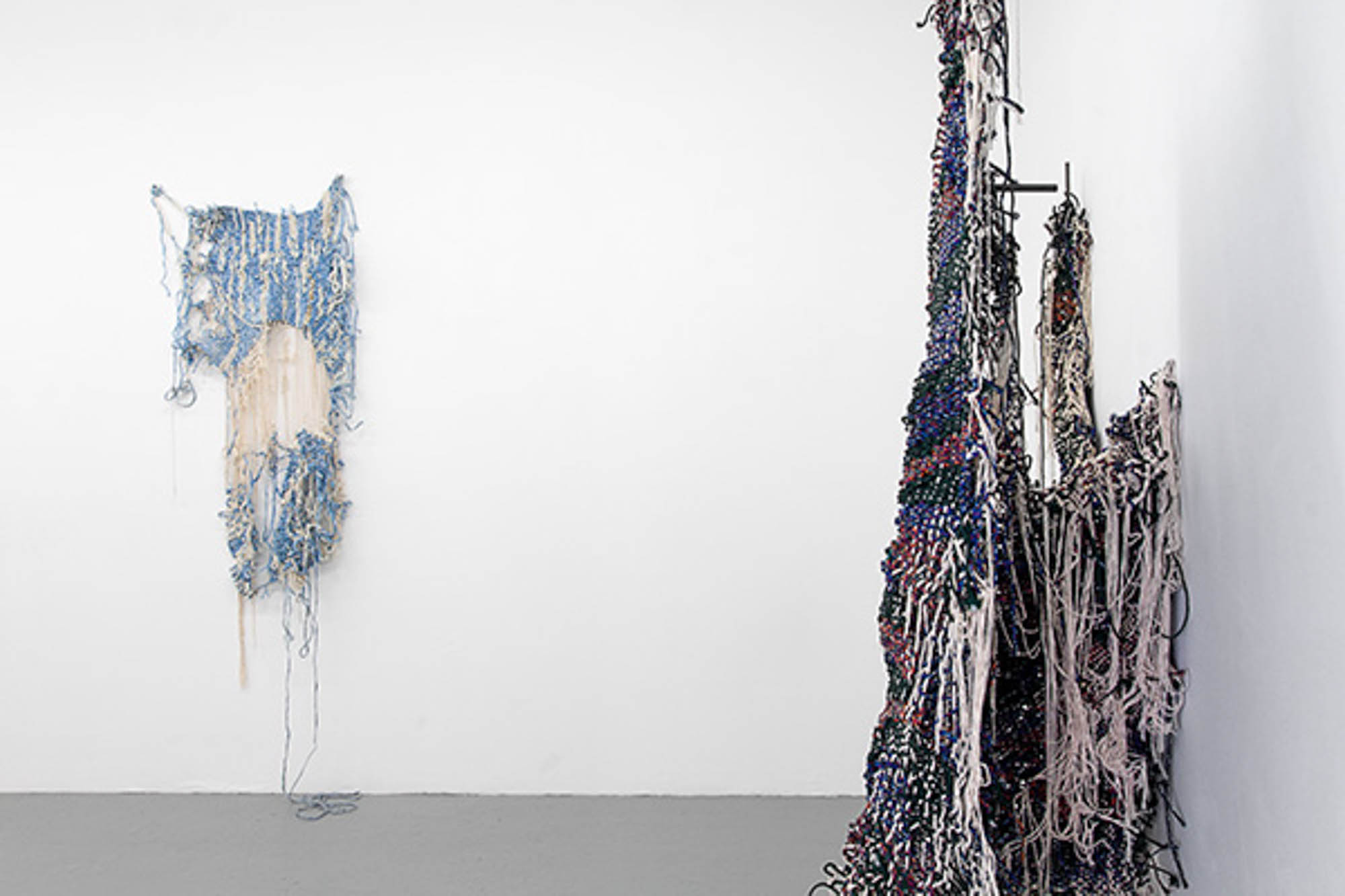


blank is pleased to present Oorskot, Igshaan Adams’ third solo with the gallery.
While in places revisiting earlier concerns, the exhibition represents an evolutionary step in Adams’ practice, both in terms of concept and form. Reflecting on his process, the artist has devised new strategies for the materialization of his ideas, evidenced in this latest body of work.
The title of the exhibition, Oorskot, is an Afrikaans word that translates as the remnants of something, or the mortal remains of a person (‘stoflike oorskot’), but can also refer to excess or surplus. Having both positive and negative associations – abundant overflow and discarded residue – ‘oorskot’ here generally refers to Adams’ use of his discarded, excess materials and other studio detritus in these new works, the careful organization of which gave rise to new forms and processes. Adams’ oeuvre is generally characterized by his use of mass-produced and waste materials (his tapestries, for example, are woven from recycled nylon rope) but in this body of work he takes it a step further, using even the remnants of remnants. This is best exemplified in Oorskot (2016), the piece that would ultimately inform the show’s title, which literally began to take form in a heap of discarded materials in a corner of Adams’ studio. Realizing that something interesting was happening, he salvaged the tangle of wire, thread and bead strings and after some careful intervention arrived at the finished artwork, a floor-to-ceiling sculptural investigation into line and texture.
Arguably, the most significant shift to take place in Adams’ new works was premised on his desire to move his tapestries off the wall, beyond the constraints of the loom and into the realm of sculpture. While exploring ways to support his freestanding tapestries, a conversation developed between Adams and sculptor Kyle Morland which quickly grew into an artistic exchange. Morland, who works primarily with mild steel, bending and contorting it into abstract compositions, began welding together framework structures for Adams to ‘inhabit’ with his weaving. The result of their collaboration – the superimposition of Adams’ organic processes onto Morland’s sculptures creates a symbiotic aesthetic; the rigidity of the steel juxtaposes the malleability of the textile, though they belong to the same entity. The impression given is that of the frameworks being ‘dressed’ by the woven material, and in the work Stoflike oorskot (2016), the weaving resembles a skin over a steel skeleton, or an unearthed burial shroud. Contributing to this imagery of decay is the surface treatment of the steel, and the dust and grime embedded in the ‘tapestry’, accumulated in the process of marrying the two elements.
Green hues dominate many of the works, the result of the artist’s gradual accumulation of green material. Culturally, the colour green is widely associated with quietude, health and vitality. In Islam, green is considered the most important colour, as it symbolises the lush vegetation of Paradise as well as the religion’s peacefulness, and it is recognised as the colour of the Prophet Muhammad’s banners and robes. An example of Adams’ prevailing use of green is the work Shahada (2016), in which the artist has experimented with a new technique using a peg loom to weave a circular shape. The title, one of the five pillars of Islam, translates as “the testimony” and declares: “there is no god but God. Muhammad is the messenger of God.”
Another work, Groen Amara (2016), takes its title from the herbal tonic for improving appetite, administered to Adams by his grandmother when he was a child. The visceral memory of the tonic’s bitterness is conveyed by the sickly colour of the green oxide dye used in the work, hinting at a more sinister tone present in the exhibition: a dark undercurrent of otherness relative to the chaos of the natural world, described by Adams as a “nightmare in which the pillars of reality have collapsed.”
While in places revisiting earlier concerns, the exhibition represents an evolutionary step in Adams’ practice, both in terms of concept and form. Reflecting on his process, the artist has devised new strategies for the materialization of his ideas, evidenced in this latest body of work.
The title of the exhibition, Oorskot, is an Afrikaans word that translates as the remnants of something, or the mortal remains of a person (‘stoflike oorskot’), but can also refer to excess or surplus. Having both positive and negative associations – abundant overflow and discarded residue – ‘oorskot’ here generally refers to Adams’ use of his discarded, excess materials and other studio detritus in these new works, the careful organization of which gave rise to new forms and processes. Adams’ oeuvre is generally characterized by his use of mass-produced and waste materials (his tapestries, for example, are woven from recycled nylon rope) but in this body of work he takes it a step further, using even the remnants of remnants. This is best exemplified in Oorskot (2016), the piece that would ultimately inform the show’s title, which literally began to take form in a heap of discarded materials in a corner of Adams’ studio. Realizing that something interesting was happening, he salvaged the tangle of wire, thread and bead strings and after some careful intervention arrived at the finished artwork, a floor-to-ceiling sculptural investigation into line and texture.
Arguably, the most significant shift to take place in Adams’ new works was premised on his desire to move his tapestries off the wall, beyond the constraints of the loom and into the realm of sculpture. While exploring ways to support his freestanding tapestries, a conversation developed between Adams and sculptor Kyle Morland which quickly grew into an artistic exchange. Morland, who works primarily with mild steel, bending and contorting it into abstract compositions, began welding together framework structures for Adams to ‘inhabit’ with his weaving. The result of their collaboration – the superimposition of Adams’ organic processes onto Morland’s sculptures creates a symbiotic aesthetic; the rigidity of the steel juxtaposes the malleability of the textile, though they belong to the same entity. The impression given is that of the frameworks being ‘dressed’ by the woven material, and in the work Stoflike oorskot (2016), the weaving resembles a skin over a steel skeleton, or an unearthed burial shroud. Contributing to this imagery of decay is the surface treatment of the steel, and the dust and grime embedded in the ‘tapestry’, accumulated in the process of marrying the two elements.
Green hues dominate many of the works, the result of the artist’s gradual accumulation of green material. Culturally, the colour green is widely associated with quietude, health and vitality. In Islam, green is considered the most important colour, as it symbolises the lush vegetation of Paradise as well as the religion’s peacefulness, and it is recognised as the colour of the Prophet Muhammad’s banners and robes. An example of Adams’ prevailing use of green is the work Shahada (2016), in which the artist has experimented with a new technique using a peg loom to weave a circular shape. The title, one of the five pillars of Islam, translates as “the testimony” and declares: “there is no god but God. Muhammad is the messenger of God.”
Another work, Groen Amara (2016), takes its title from the herbal tonic for improving appetite, administered to Adams by his grandmother when he was a child. The visceral memory of the tonic’s bitterness is conveyed by the sickly colour of the green oxide dye used in the work, hinting at a more sinister tone present in the exhibition: a dark undercurrent of otherness relative to the chaos of the natural world, described by Adams as a “nightmare in which the pillars of reality have collapsed.”
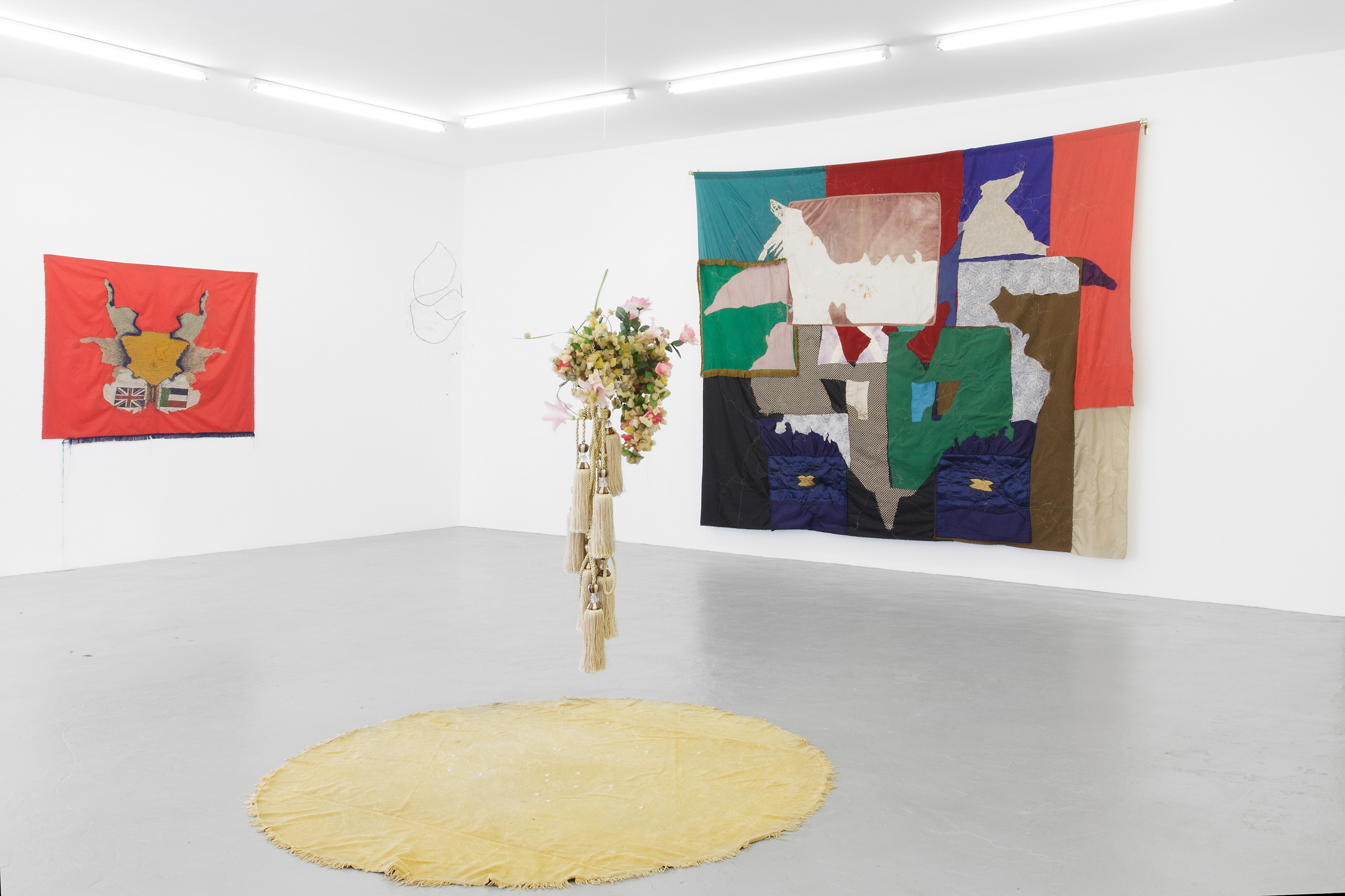
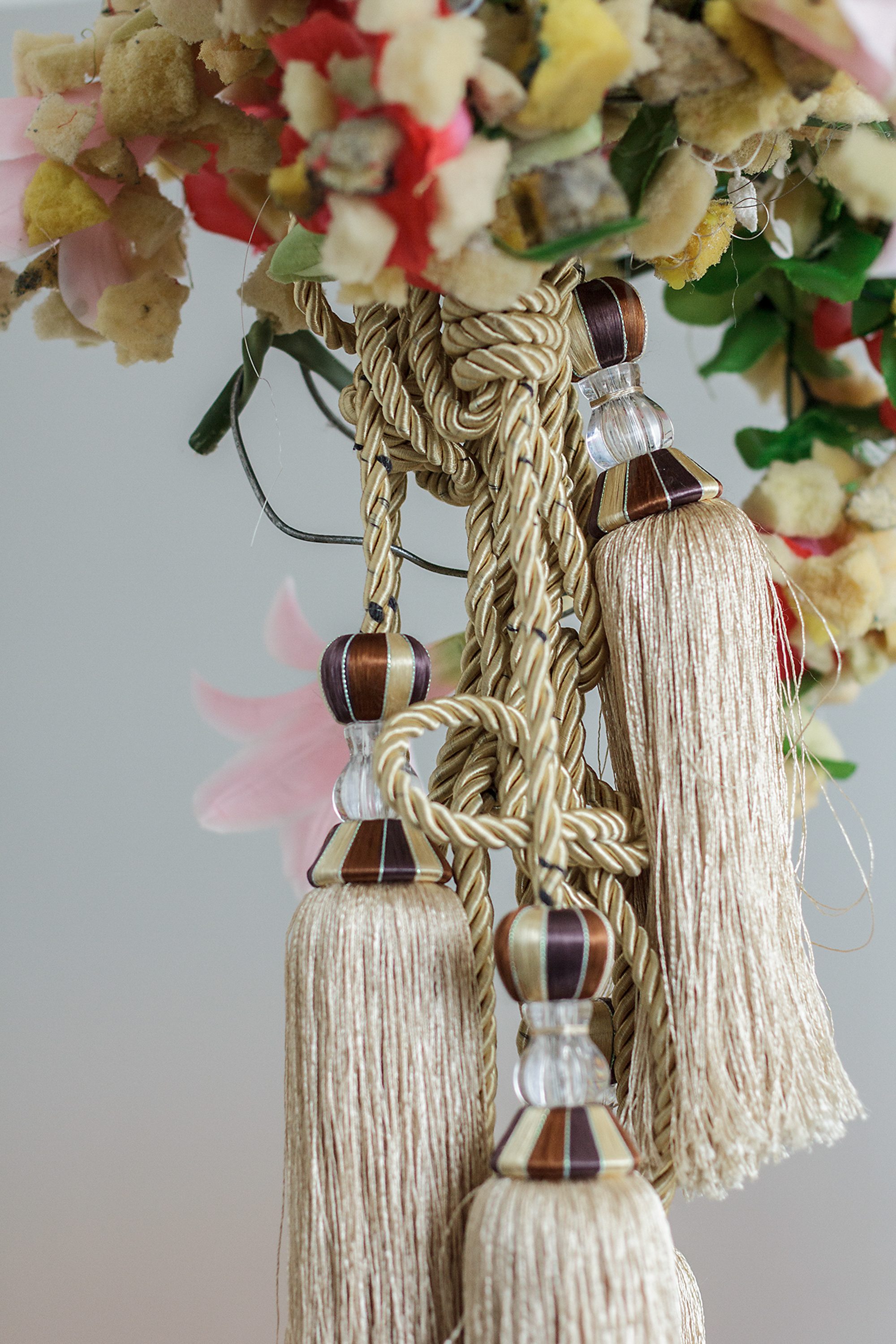

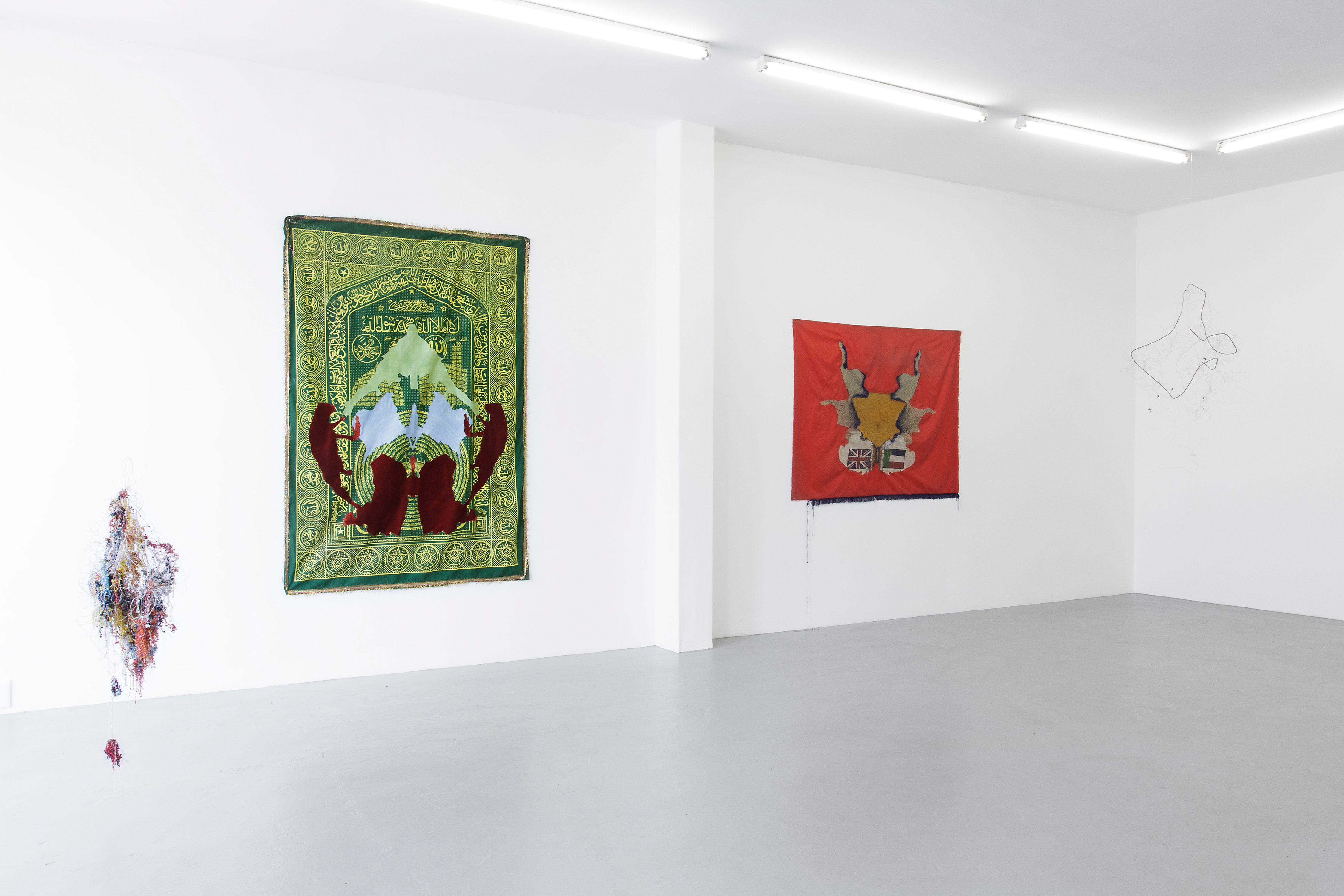

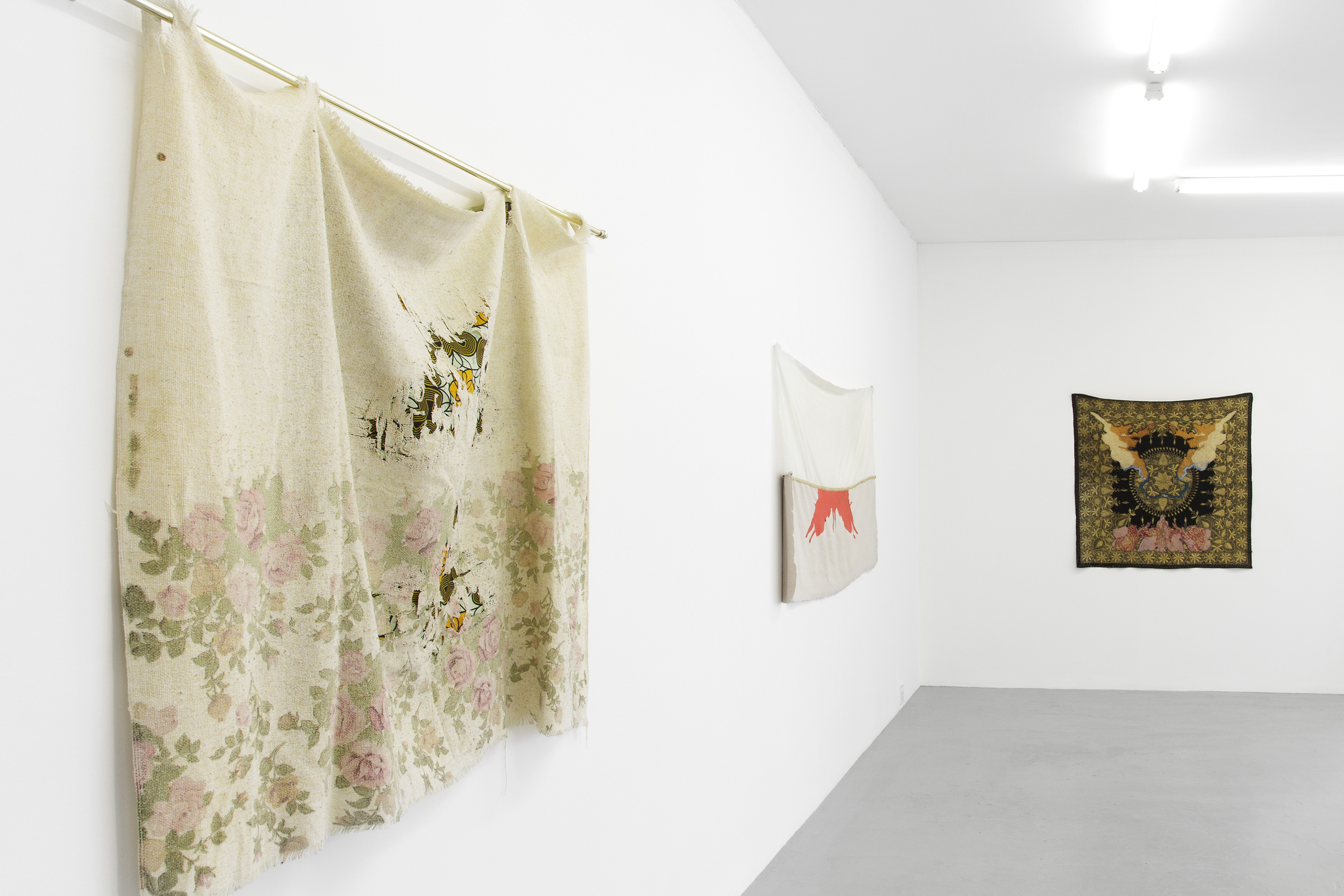
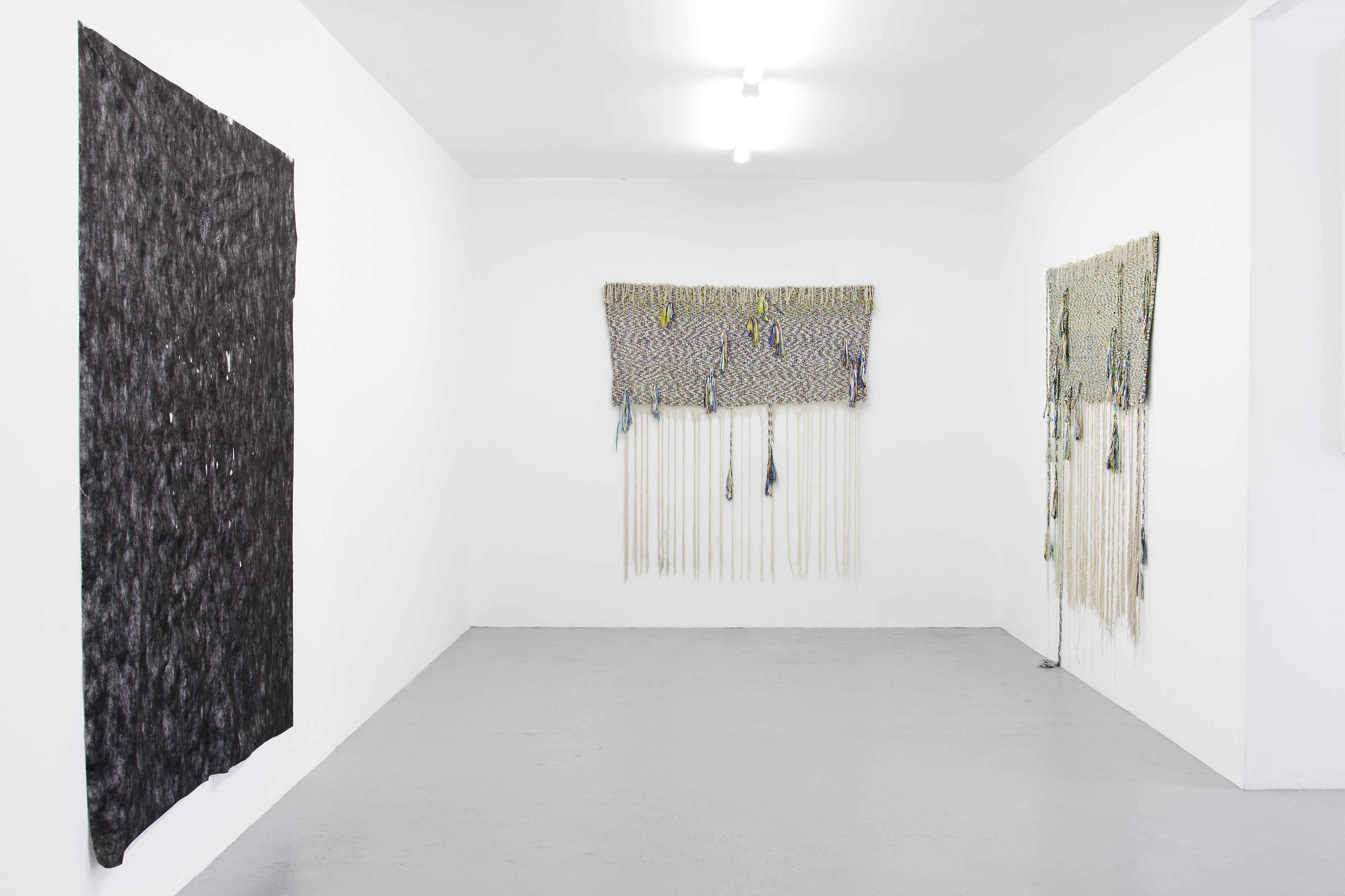
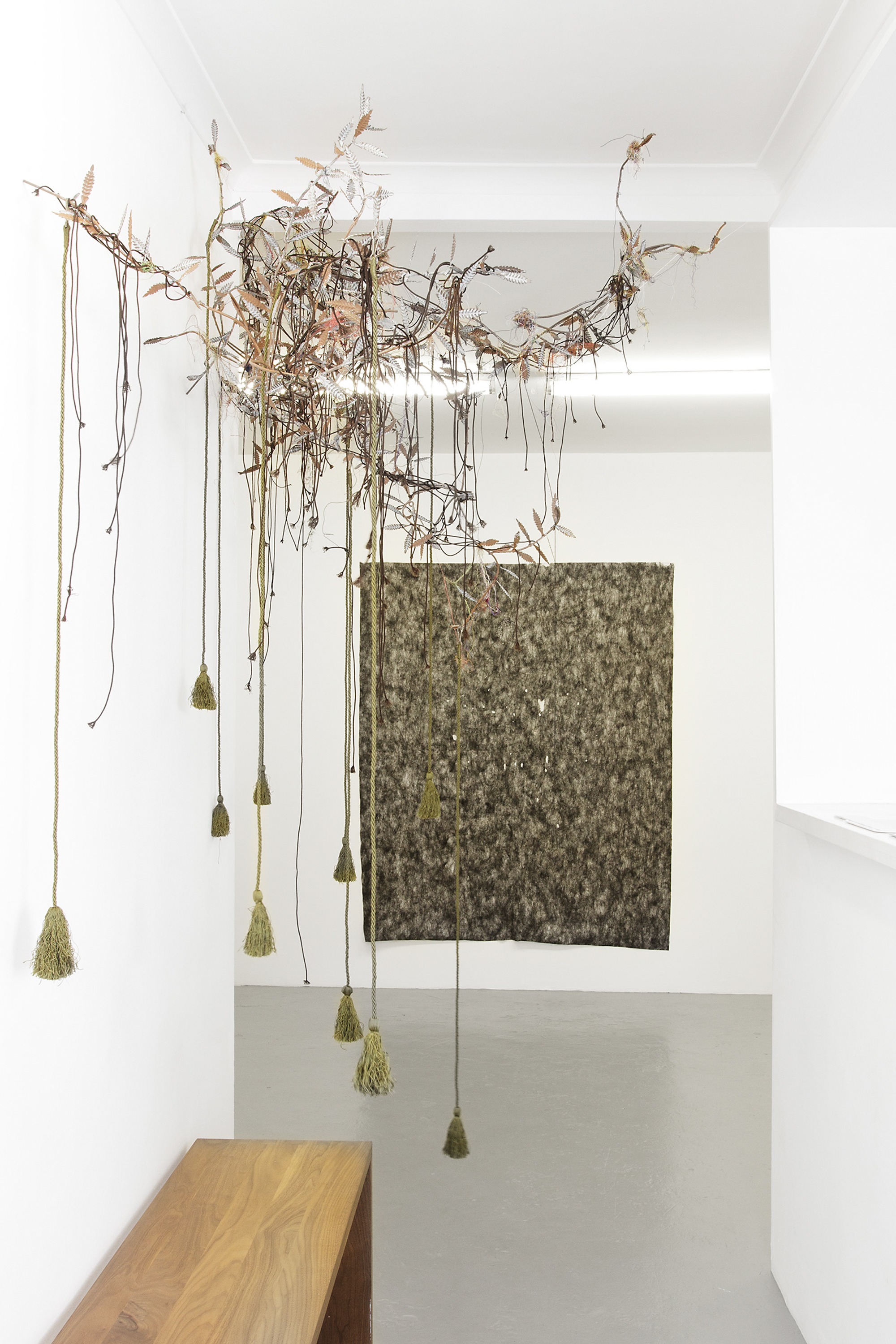



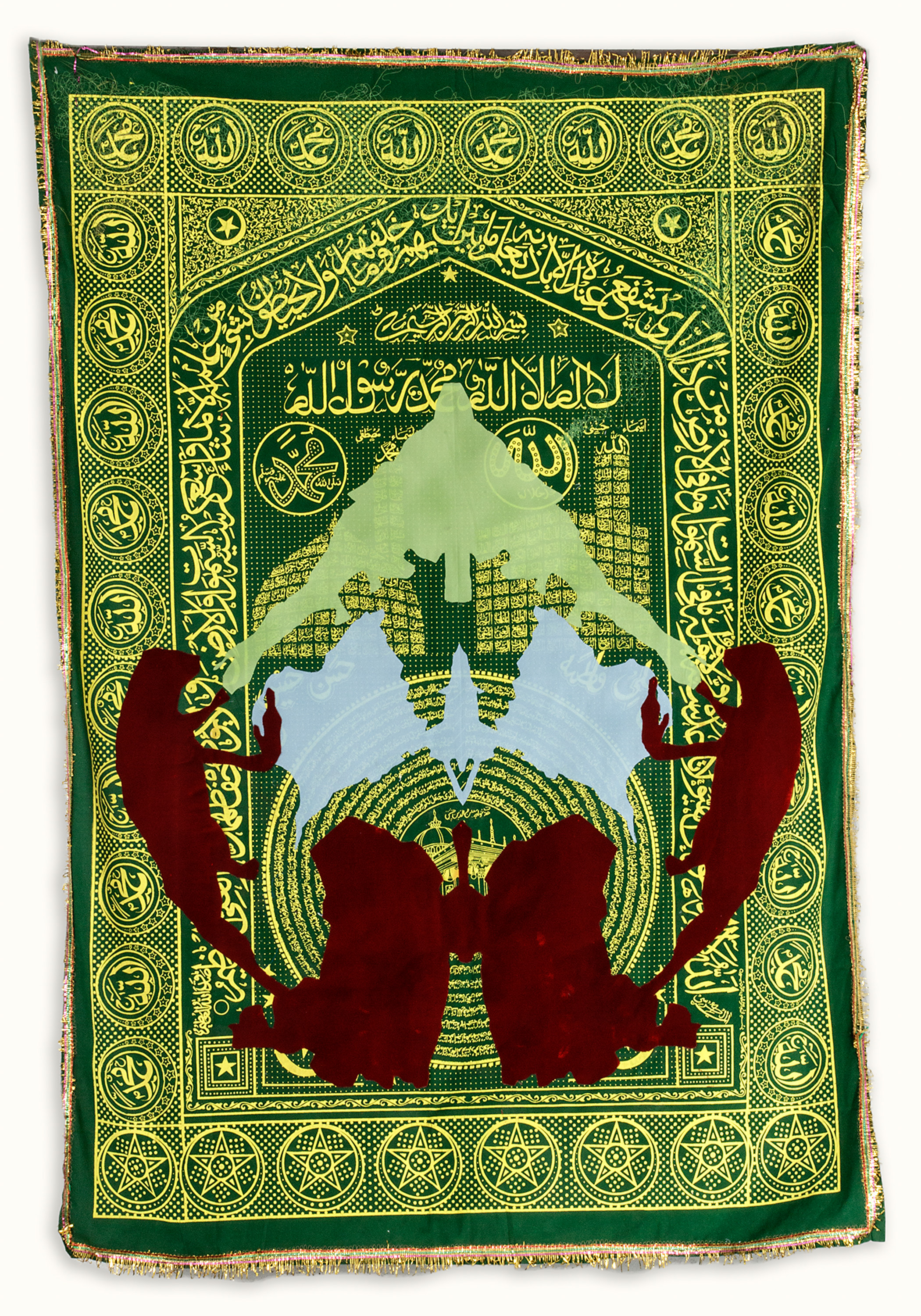
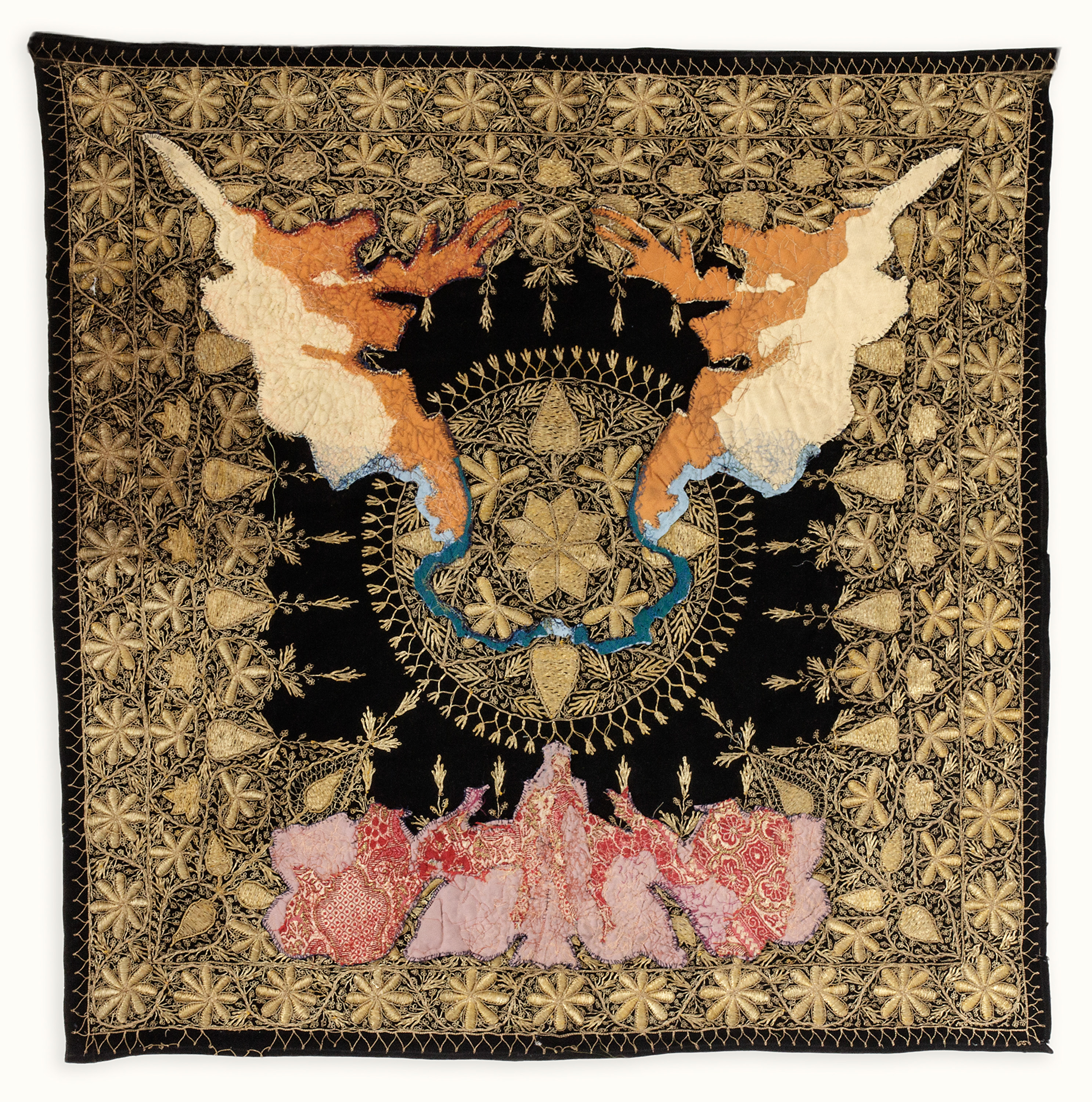

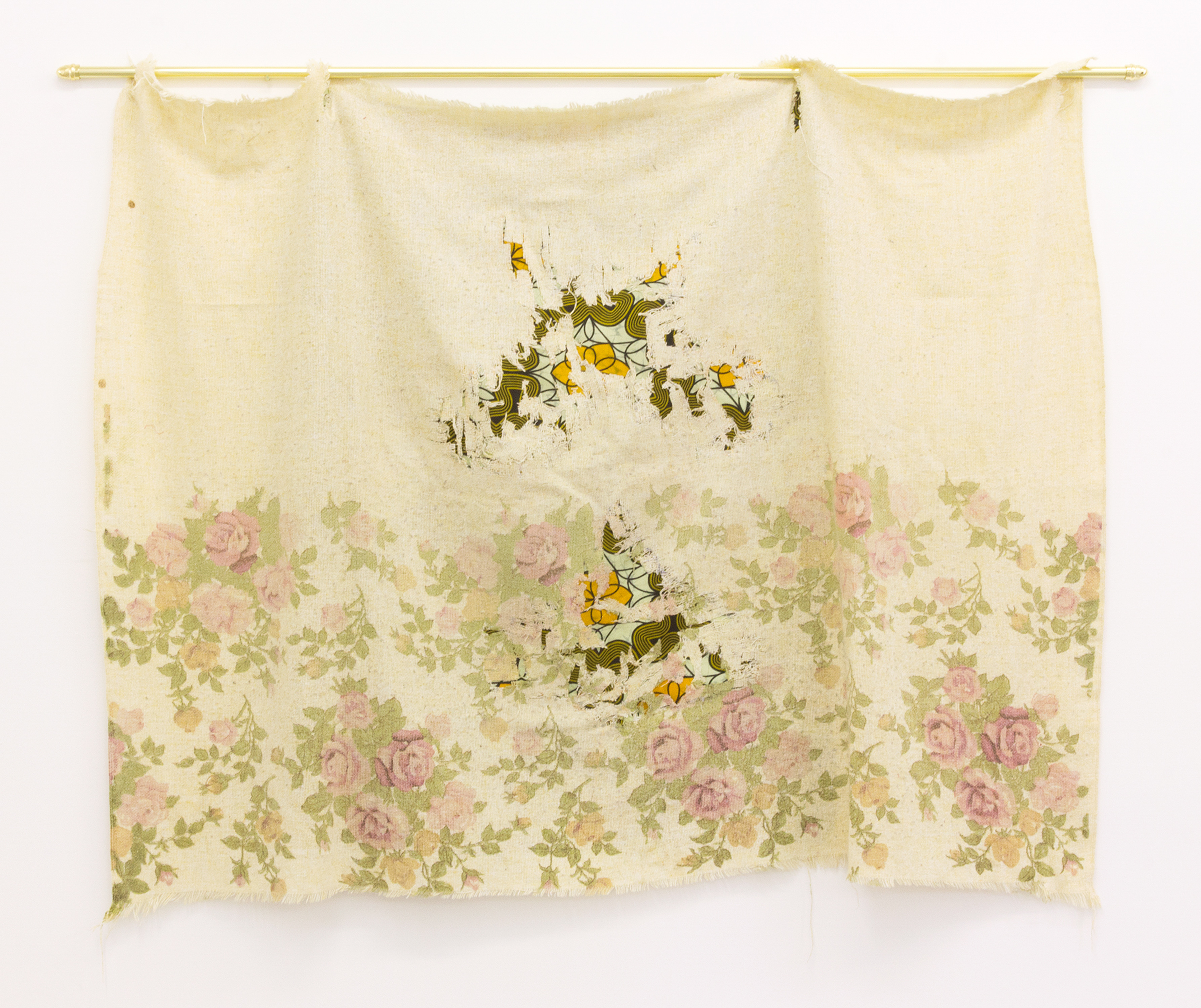
Igshaan Adams’ work investigates hybrid identity, particularly in relation to race and sexuality. Adams was raised in a community racially classified in South Africa as ‘coloured’ under apartheid legislature. The term ‘coloured’ is still used in South Africa to refer to the creole community of mixed raced origins. An observant but liberal Muslim raised by Christian grandparents, Adams occupies a precarious place in his religious community because of his homosexuality. His work speaks to his experiences of racial, religious and sexual liminality, but breaks with a strong representational convention in recent South African art. Adams uses the material and formal iconographies of Islam and ‘coloured’ culture to develop a more equivocal, phenomenological approach towards these concerns.
The sculptures, installations, tapestries and banners constituting Parda were conceived during Adams’ participation in the Sommerakademie at the Zentrum Paul Klee in Bern in 2014, guest curated by Raimundas Malasauskas. The works draw from Hermann Rorschach’s inkblot tests, and seek to explore the idea of exposing underlying beliefs, mental patterns and blindspots through analysing projections. In developing this body of work, Adams sought to subjectively explore the structure of the test (form, colour, movement, and the sequence of the ten plates) and its claim to expose mental abnormalities. The title ‘Parda’ refers to a veil or a curtain; a flimsy protective layer that conceals an identity. In Islam it refers to the covering of a women’s face as prescribed by Sharia laws and has become a symbol of the oppression of women in some parts of the Muslim world.
Apparent in Adams’ work is “the vital role that fabric as a medium plays in his artistic dialogues. Some of Adams’ earliest childhood memories include going to work with his mother on a Saturday. His mother was a machinist – constantly crafting a range of textiles – and this environment started to cultivate Adams’ passion for material and tactile mediums. [His] use of textiles exemplifies the strong feminine influence during his formative years, when the matriarchs in his family had a significant impact on him. It echoes the domestic environment, a prevalent theme in Adams’ oeuvre, as well as raising issues of sexuality and the questioning of stereotypes.”
– Daniel Hewson, ‘Bright Young Things.’ ARTsouthAFRICA, December 2014
The sculptures, installations, tapestries and banners constituting Parda were conceived during Adams’ participation in the Sommerakademie at the Zentrum Paul Klee in Bern in 2014, guest curated by Raimundas Malasauskas. The works draw from Hermann Rorschach’s inkblot tests, and seek to explore the idea of exposing underlying beliefs, mental patterns and blindspots through analysing projections. In developing this body of work, Adams sought to subjectively explore the structure of the test (form, colour, movement, and the sequence of the ten plates) and its claim to expose mental abnormalities. The title ‘Parda’ refers to a veil or a curtain; a flimsy protective layer that conceals an identity. In Islam it refers to the covering of a women’s face as prescribed by Sharia laws and has become a symbol of the oppression of women in some parts of the Muslim world.
Apparent in Adams’ work is “the vital role that fabric as a medium plays in his artistic dialogues. Some of Adams’ earliest childhood memories include going to work with his mother on a Saturday. His mother was a machinist – constantly crafting a range of textiles – and this environment started to cultivate Adams’ passion for material and tactile mediums. [His] use of textiles exemplifies the strong feminine influence during his formative years, when the matriarchs in his family had a significant impact on him. It echoes the domestic environment, a prevalent theme in Adams’ oeuvre, as well as raising issues of sexuality and the questioning of stereotypes.”
– Daniel Hewson, ‘Bright Young Things.’ ARTsouthAFRICA, December 2014






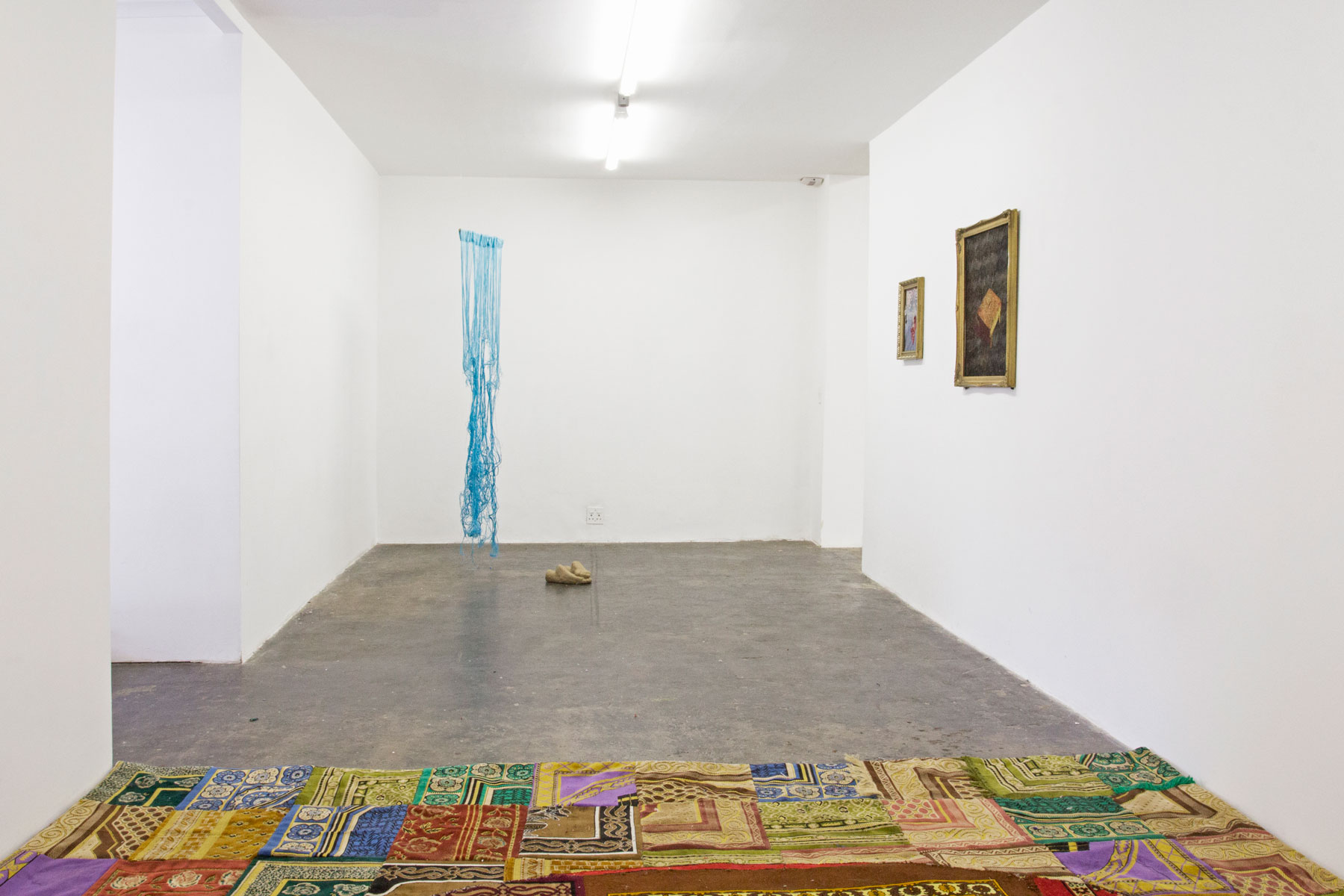

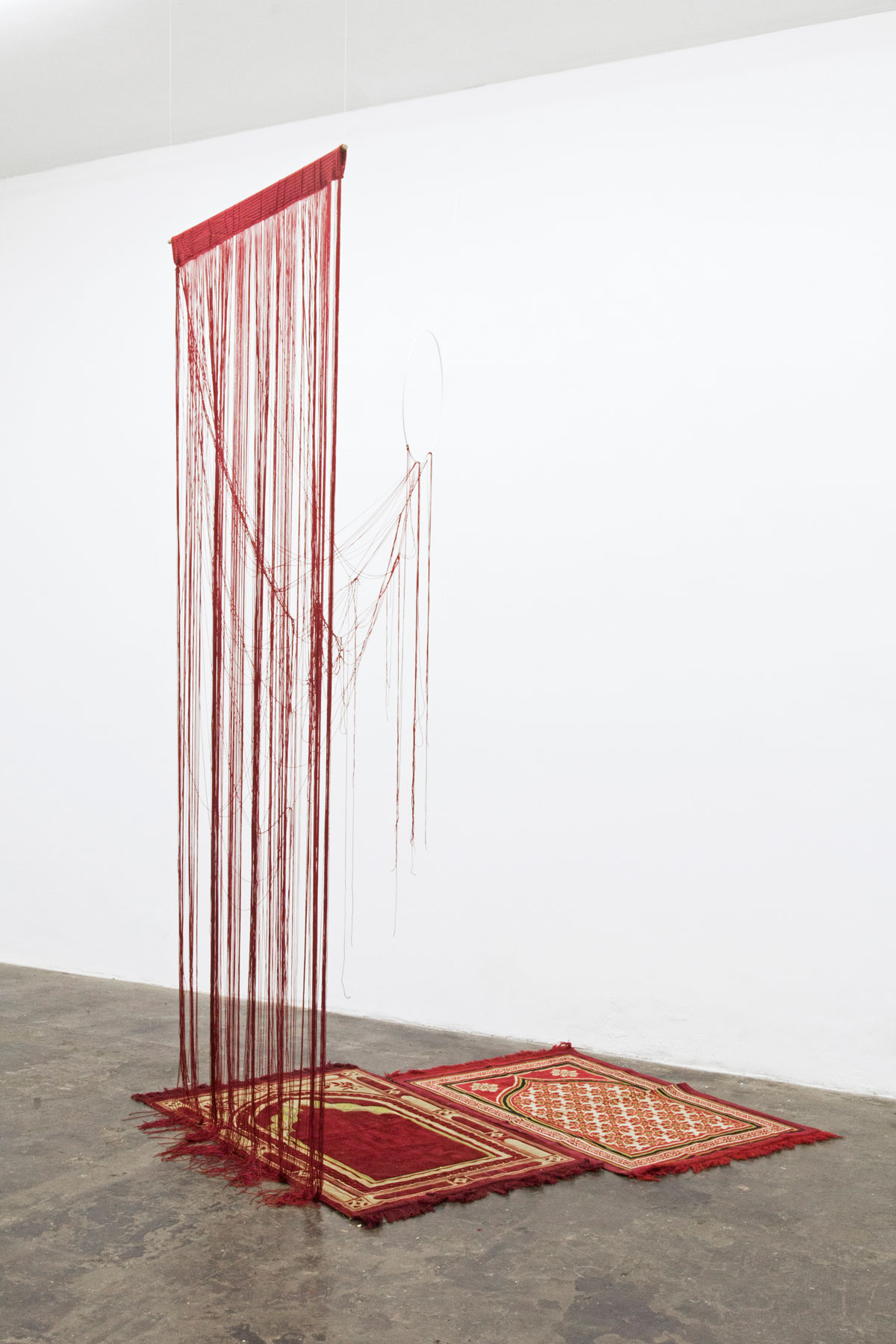







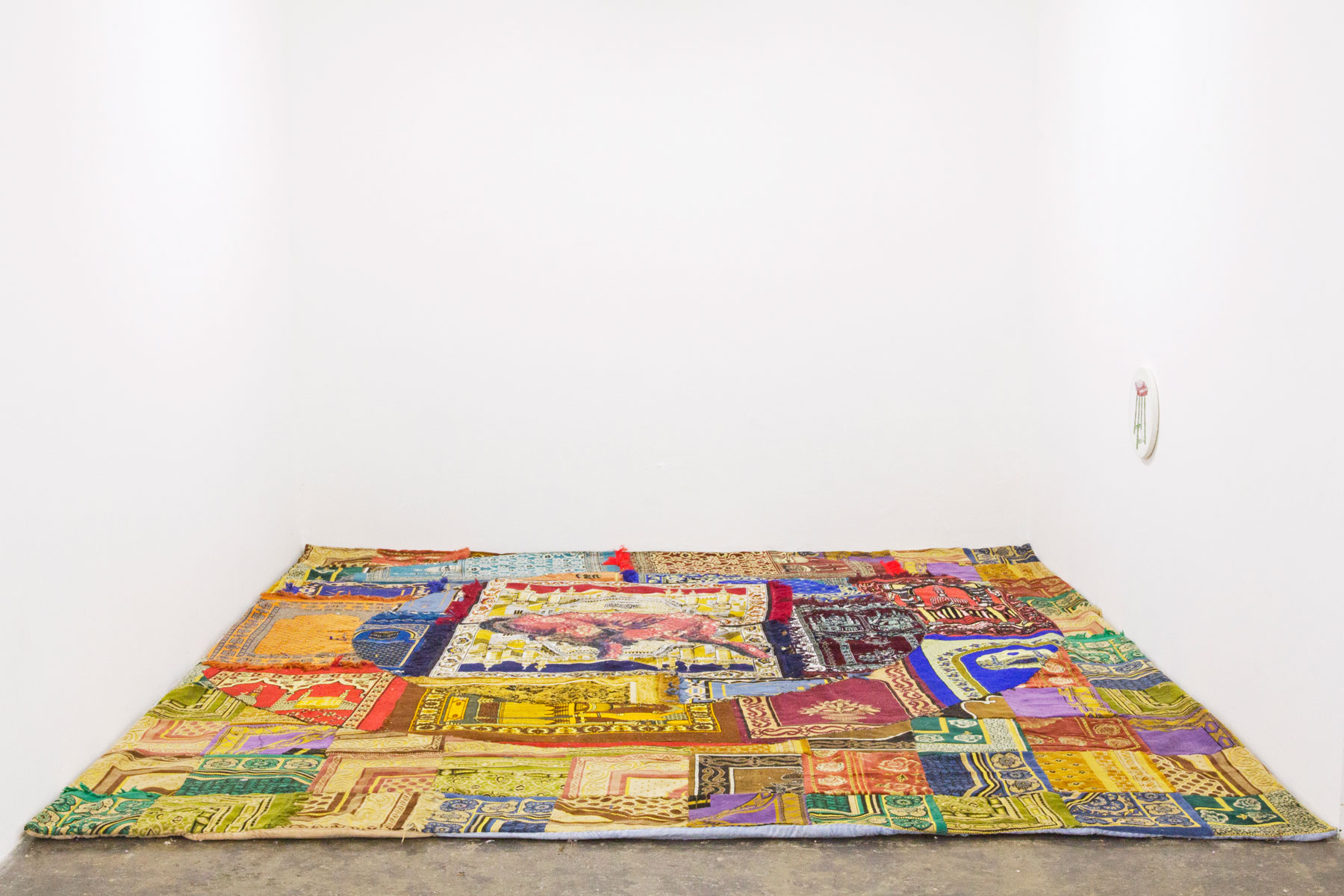


The title of the exhibition references fabled sayings by Mullah Nasiruddin, the 13th century Seljuq satirical Sufi who is often referred to as ‘the
wise fool’. Adams identifies with the populist philosopher’s often humorous searches for God in domestic and other commonplace objects.
The exhibition features installation works and embroideries. The latter represents furniture pieces based on particular objects of personal, family and religious significance. Adams renders the objects incomplete, or with structural weaknesses counter to their quotidian functionality. The array of predominantly textile-based installations allude to disturbances within the comforts of home: explicating what happens when home becomes a place of danger.
The personal narrative that runs through the work culminates in If that I knew, the largest installation in the exhibition. The focal point of this work is a carpet of prayer mats representing a prone dog juxtaposed with the patterns and architectural elements inherent in the design of the carpets. Adams explains: “In Islam the dog is considered an impure animal. Superimposing the image of the dog on the Holy City is an act of claiming a stake despite rejection and ridicule. All the works in this body are conversations: between God and myself, moments and experiences. These conversations are often argumentative, conflictual, yet, intimate and at times reassuring.”
The exhibition features installation works and embroideries. The latter represents furniture pieces based on particular objects of personal, family and religious significance. Adams renders the objects incomplete, or with structural weaknesses counter to their quotidian functionality. The array of predominantly textile-based installations allude to disturbances within the comforts of home: explicating what happens when home becomes a place of danger.
The personal narrative that runs through the work culminates in If that I knew, the largest installation in the exhibition. The focal point of this work is a carpet of prayer mats representing a prone dog juxtaposed with the patterns and architectural elements inherent in the design of the carpets. Adams explains: “In Islam the dog is considered an impure animal. Superimposing the image of the dog on the Holy City is an act of claiming a stake despite rejection and ridicule. All the works in this body are conversations: between God and myself, moments and experiences. These conversations are often argumentative, conflictual, yet, intimate and at times reassuring.”